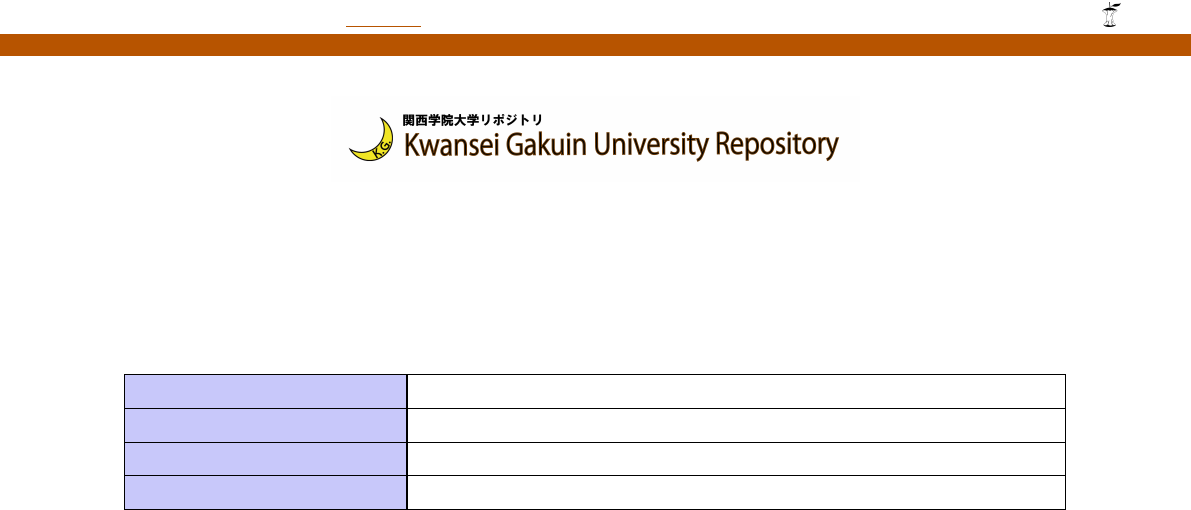1
Doctoral Dissertation
for Doctoral Degree
Kwansei Gakuin University
An analysis on the Japanese Omotenashi from the service-
dominant logic perspective
Advisor: Professor Yamamoto Shoji
Graduate Department of Advanced Management(Ph.D)
June,2016
Institute of Business and Accounting
73013901 Alalsheikh Abdulelah

2
Structured Abstract:
Purpose: The Service-Dominant logic, being a service-centered view of an organization, has been the subject of
conceptual debate over the past decade. Given the fact that Japanese hospitality industry has been notably
regarded as customer-oriented and the one aimed at providing one-of-a-kind experience to the guests in terms of
the offered service, the extent of influence the Service Dominant logic premises have possibly made on Japanese
hospitality industry is to be studied. Tea ceremony practice, kaiseki restaurant (Kitcho) and traditional Ryokan
Inn (Kagaya) have been chosen for practical examination and analysis on the basis of the theoretical overview as
those are commonly known as the main hospitality industry outlets preserving the traditions and cultural
implications of the Japanese philosophy and Omotenashi.
Therefore, the purpose of the dissertation is to theorize and explain the process of co-creation of pivotal
customer value as an Omotenashi, on the basis of the theoretical and practical examination of service-dominant
logic as evidenced in the Japanese conceptions of service hospitality in the kaiseki restaurant and the traditional
Japanese inn settings.
Design/methodology/approach: The current literature on the subject of the Service Dominant logic is reviewed
by using case study research method, the key principles of Japanese tea ceremony in its symbiosis with
Omotenashi are reviewed and summarized, and the service provided by Japanese Ryokan inn and kaiseki
restaurant is studied from two visits to Kagaya hotel and Kyoto Kitcho restaurant. Additionally, the differences
and similarities between Ritz hospitality and Hoshinoya Omotenashi as Western superior hospitality versus
Japanese Omotenashi will be reviewed in respect to defining the common and opposite features of these two
service delivery styles. Other relevant scholarly works are cited where appropriate. One of the researches posing
a special value for the given work in terms of relevant and up-to-date information is the article named The influence
of the Japanese tea ceremony on Japanese restaurant hospitality by Sato and Parry (2015). Moreover, some of the
author's previous works completed in the frame of pre-doctoral research are fractionally included into the text of
the present dissertation wherever relevant and appropriate.
Findings: Both Kagaya hotel and Kitcho restaurant carry certain implications of Omotenashi, and drawing
parallels with the ten foundational premises of Service Dominant logic may be possible. Nonetheless, it does not
indicate that neither Kagaya nor Kitcho, bearing significance in regards to traditional principles of Japanese
cultural, spiritual and social aspects, has been influenced by the Service Dominant logic premises. More so, an in-
depth analysis of the managerial roles executed by Kitcho Okami and Kagaya Okami has demonstrated that the
nature of Omotenashi presented in Kitcho restaurant and Kagaya inn respectively; is influenced more by the

3
personal traits of Okami rather than Service Dominant logic principles. Within the course of the research, the
following research questions have been answered:
1. What are the origins of the Japanese Omotenashi?
2. What are the connections between Omotenashi and the Japanese tea ceremony?
3. What role does Omotenashi play in the service delivery process of kaiseki restaurant?
4. What are the differences between Omotenashi and hospitality (on the example of the comparison
between the Japanese inn and regular hotel)?
5. What role does Omotenashi play in the service delivery process of the traditional Japanese inn?
Research limitations/implications: The analysis focused on two elite hospitality industry places: Kitcho
restaurant and Kagaya hotel. It is emphasized that the conclusions drawn from the research are relevant in respect
to the reviewed literature and practical experiences described in the correspondent sections of the dissertation.
Therefore, the experience received in any other place, even if it is regarded as executing the same principles and
preserving the same traditions, may differ from the one described. Nonetheless, whenever the service process
includes positive value co-creation, the model of this research shall become equally relevant. Some potential
examples include tea ceremony, other Japanese restaurants, hot springs, spa salons, and other places where the
process of value co-creation between the guest and the server is particularly relevant.
Originality/value: The Service Dominant logic implications emphasize that the knowledge of business techniques
and managerial techniques are no longer required for providing excellent service. Taking into consideration the
fact that Japanese service concept, being largely based on the principles of Omotenashi, has not been dependent
upon the business and managerial practices to the extent observed in Western-style businesses, the following
question arises: “To what extent, if any, has Japanese service industry been influenced by the Service Dominant
logic?”. In order to analyze the possible value this answer holds, it is necessary to mention that the Service
Dominant logic foundational premises can be viewed together with Omotenashi principles as complementary, yet
not consequent. The originality of the dissertation also lies in the fact that it attempts a complex analysis and
discussion of the five raised research questions in order to draw evidence-based conclusions and satisfy the set
purpose.
Key words: Omotenashi, value co-creation, Service Dominant logic, tea ceremony, kaiseki

4
Contents
Chapter 1. Introduction ....................................................................................................................................... 5
Chapter 2. The Origins of the Japanese Omotenashi. ....................................................................................... 7
2.1. Japanese history as the origin of the Japanese Omotenashi. ..................................................................... 7
2.2. Japanese social philosophy as the origin of the Japanese Omotenashi. .................................................. 11
Chapter 3. The Omotenashi and the Japanese tea ceremony. ........................................................................ 20
Chapter 4. The Omotenashi and the Kaiseki Restaurant. .............................................................................. 30
Chapter 5. The differences between Omotenashi and hospitality: hotel and Japanese inn. ........................ 36
Chapter 6. The Omotenashi and the traditional Japanese Inn. ...................................................................... 53
Chapter 7. The differences between Western hospitality and Omotenashi. .................................................. 65
Chapter 8. Conclusion. The theoretical and practical implications. .............................................................. 71
References ........................................................................................................................................................... 74

5
Chapter 1. Introduction.
Modern Japan has seen an increase in the number of tourists coming to visit the country that is globally
known for its technological discoveries and rapid economic advancements. According to Japan National
Tourism Organization annual report, the total of 5,752,800 foreign visitors have come to Japan during the first
three months of 2016 (January-March). Comparing these figures from the data of year 2011 (1,746,168 foreign
visitors from January 2011 to March 2011), it is evident that Japan has experienced a threefold rise in the
number of tourists over the past five years. The reasons of the augmented tourist ratio in Japan may range to
reflect the reduced visa requirements for southeast countries, other Japanese government policies to increase
foreign visitors in the upcoming decades, the overall Japanese economic growth, its break-through in the field of
electronics and automotive industry, and so on. However, there is an aspect of the country which attracts yet
more tourists than its technology advancement: Japanese culture. Although rapidly advancing in the economy
and technology, Japan is known for its traditional and authentic approaches in the field of customer service.
Most importantly, Omotenashi as the main concept of service delivery in kaiseki restaurant and the traditional
Japanese inn, as well as the fundamental element of other spheres of the Japanese service and hospitality
industry, has been the aspect that attracts those who seek to experience the authentic Japanese culture to the
country.
Therefore, Omotenashi as the main concept of service delivery in kaiseki restaurant (Kitcho) and the
traditional Japanese inn Ryokan (Kagaya) is the central topic of the presented dissertation. The purpose of the
dissertation is to theorize and explain the process of co-creation of customer value, pivotal for Omotenashi, on
the basis of the theoretical and practical examination of the Service-Dominant logic as evidenced in the
Japanese conceptions of service hospitality in the kaiseki restaurant and the traditional Japanese inn settings.
The five research questions that the purpose of the dissertation necessitates to be resolved are as follows:
1. What are the origins of the Japanese Omotenashi?
2. What are the connections between Omotenashi and the Japanese tea ceremony?
3. What role does Omotenashi play in the service delivery process of kaiseki restaurant?
4. What are the differences between Omotenashi and hospitality (on the example of the comparison
between the Japanese inn and regular hotel)?
5. What role does Omotenashi play in the service delivery process of the traditional Japanese inn?
6. What are the differences between Western superior hospitality and Omotenashi (Ritz and Hoshino)?

6
The next six chapters will respectively examine, discuss and answer the correspondent research
questions. The final eighth chapter will draw the conclusion with outlining the theoretical and practical
implications of the dissertation.
The research mythology:
Qualitative research method was used to answer the research questions for the dissertation. The author
collected the data of the case companies, implemented the case study research to clarify the research questions
based on the data, got the hypotheses to explain the research questions, and finally visited Kagay Ryokan in
Ishikawa prefecture, and Arashiyama Kitcho of Kaiseki restaurant to verify and supplant the hypotheses. The
author also has just started to work in a ryokan, izuyasu as a part-time jobber to verify and generalize the
hypotheses. The author has also learnt tea ceremony and flower arrangement for 2 years, and studied Iadio,
Japanese marital art the way of the sword for 3 years to understand its philosophy, especially Japanese Do.
These author’s experience of Japanese traditional culture contributed to write this doctoral dissertation very
much.

7
Chapter 2. The Origins of the Japanese Omotenashi.
The origins of the Japanese Omotenashi appear to be a reciprocative symbiosis between the
geographical location of Japan, its rice agriculture, tea ceremony, Kata, the historical and modern Japanese
social structure, samurai and the bushido code, Japanese collectivism norm, Japanese isolation “Sakoku”, and
the Japanese brain as the key defining factor of the Japanese behavior. All these separate aspects can be united
into two major groups, namely the Japanese history, from which the geographical location of Japan, its rice
agriculture, tea ceremony, and “Sakoku” are defined; and the Japanese social philosophy pertaining to social
structure, samurai and the bushido code, Japanese collectivism norm, Kata, and the Japanese brain. These two
groups will be extensively discussed in the next two sections of this chapter.
2.1. Japanese history as the origin of the Japanese Omotenashi.
Japan, being a chain of Volcano Islands surrounded by the sea, has been geographically both protected
and isolated from the influence of other countries. Whereas the coastal borders and the sea historically served as
the natural shield annulling the possibility of unexpected and unwarranted foreign aggression, the isolation from
the rest of Asian countries and the world set Japan onto the route of self-development and the establishment of
needed harmony amongst its population. Moreover, the natural disasters frequently occurring due to the
volcanic nature of the Japanese islands have formed a strong bond between all the citizens of the country. Two
of recent natural disasters in Japan were the earthquake in Kobe in 1994 and in Tohoku in 2011. Nicholas
Kristof talked about Hanshin-Awaji Earthquake in Kobe in an article in the New York Times:
“But the Japanese people themselves were truly noble in their perseverance and stoicism and
orderliness. There’s a common Japanese word, “gaman,” that doesn’t really have an English
equivalent, but is something like “toughing it out.” And that’s what the people of Kobe did, with a
courage, unity and common purpose that left me awed.
Japan’s orderliness and civility often impressed me during my years living in Japan, but never more so
than after the Kobe quake. Pretty much the entire port of Kobe was destroyed, with shop windows
broken all across the city. I looked all over for a case of looting, or violent jostling over rescue supplies.
Finally, I was delighted to find a store owner who told me that he’d been robbed by two men.
Somewhat melodramatically, I asked him something like: And were you surprised that fellow Japanese
would take advantage of a natural disaster and turn to crime? He looked surprised and responded, as I
recall: Who said anything about Japanese. They were foreigners”. (Kristof, 2011).

8
The consolidation in the time of troubles, which occurred quite often over the Japanese history, helped
the Japanese people stay aloft and rebuild what got ruined, be it their town that had suffered from an earthquake,
or the nation’s economy that had suddenly inflated, or any other catastrophe of any degree. Therefore, the ability
to stay calm and unite for the commonly beneficial result during the critical moments in the nation’s history has
bent the Japanese people toward perceiving harmony as something ultimately important. Both on the national
and individual levels, the Japanese people prioritize harmony to be the cornerstone of any social interaction or
deed. There are two words in the Japanese language that come the closest to explaining the role of harmony in
the Japanese society. “Wa” – the Japanese word for harmony – explains all aspects of their life and serves as the
basis for Japanese Omotenashi. “Yamato”, from another hand, traces back to the times when Japan was called
the Yamato clan, literally meaning “among people”, and, thus, it explains the consolidating nature harmony has
in Japan. It is due to the geographical position of the country and its natural isolation from the rest of the world,
as well as the high occurrence of natural disasters on the islands, that harmony has taken an essential stand in the
hearts of the Japanese people and laid the foundation for Omotenashi – the Japanese spirit of hospitality and
service.
Rice agriculture also played an important role in lying off the foundation upon which the Japanese
philosophy and concept of Omotenashi would later surface. Japan imported the tradition of rice agriculture from
China between the Jōmon period (12,000 BC) and the Yayoi period (300 BC to 300 AD). The tradition of rice
agriculture has largely influenced the Japanese country’s social behavior patterns. The survival of each village
depended on the mutual concern and cooperation of the business and their neighbors, which is why the harmony
was the key factor that affected business, politics, and education very deeply at that time, and still does in
modern Japan.
De Mente (2014, p.25) expressed the following idea about the rice agriculture in Japan: “Wet-rice
farming, in such a limited area imbued the Japanese with an extraordinary degree of patience, perseverance,
diligence, cooperativeness and group dependence because this kind of farming required very elaborate irrigation
systems that could not easily be built and maintained or protracted from marauders by single families”.
Therefore, in the environment of survival, harmony and cooperation within a social group were they
key factors that ensured that every member of the society could make a living and remain protected. Apart from
emphasizing on being harmonized and cooperative, the Japanese took more lessons from wet-rice farming that
an outsider could have imagined. De Mente (2014, p.26) continues:

9
“Among the most conspicuous Japanese traits said to have been fostered by wet-rice farming was the
acceptance of discipline and regimentation. The individual who did not conform was quickly ostracized
to protect and sustain the group. [...] The whole economic base of the country therefore became one
giant rice-raising kata that made group behavior, cooperation, self-sacrifice and harmony mandatory”.
It is indeed a curious phenomenon, taking into consideration that the history evidences that monetary
benefit was not the primary focus of the wet-ricing farmers. Naturally, the rice agriculture proved to be
advantageous for survival and making a family’s living, however, these were not the exclusive points of
engaging into the wet-rice farming activity. Wet-rice farming was also much subject to forming social groups
and developing long-lasting and productive relations within a community. Also, working on the rice fields
helped the Japanese fully understand and adopt the importance of harmony and self-sacrifice. This all is what is
still true in the modern Japanese society and what continues to stand at the roots of modern Omotenashi, as well.
If one speaks of current Omotenashi in respect to the newly emerged Service Dominant logic, value co-
creation instantly becomes the aspect both Omotenashi and Service Dominant logic largely contain. According
to Yi and Gong (2013, p.1279), some of the vital aspects of value co-creation, under which it becomes possible,
include: “information seeking, information sharing, responsible behavior, and personal interaction, whereas the
aspects of customer citizenship behavior are feedback, advocacy, helping, and tolerance”. Looking closely,
these are precisely the aspects wet-rice farming had fostered in the minds of the Japanese people in regards to
their social interaction. Therefore, it can be concluded that rice agriculture has also proved to be one of the
historical origins of the Japanese Omotenashi.
Looking from the historical perspective, the beginning of the Japanese tea ceremony’s implementation
into Japanese culture and its becoming a spiritual experience embodying tranquility, purity, and respect and
hospitality date back as far as to the middle of fourteenth century. At that time, traditional tea ceremony was a
common practice among the nobility and priests. They gave it its original form and made it spread among the
higher social classes. Later, especially during the times of civil warfare that took place in the fifteenth and the
beginning of sixteenth centuries, great warlords and merchants with their retainers spread the popularity of the
tea ceremony among different social classes and communities.
Therefore, tea ceremony and the Japanese Omotenashi have much in common and appear to be
interconnected, where the aspects of the philosophy they both execute and are based on overlap to an extreme
degree. In the Japanese concept of hospitality, the server provides the service without an expectation of a
returned favor and is not solely driven by the monetary compensation. Serving the guests, particularly during the

10
Japanese tea ceremony, implies ensuring the guests' positive impressions and two-sided learning and
cooperation. The host contributes to the guest's well-being and positive emotions just as the guest contributes to
the host's. Setting a happy, relaxed mood and driving away from the mundane reality by creating a tranquil
atmosphere are one of the key goals of the Japanese tea ceremony, and, consequently, Omotenashi. If viewed
within the domain of Japanese hospitality industry, the aspects of value co-creation and interaction between the
host and the server extensively covered by the modern service industry phenomenon named S-D Logic seem to
be sharing much in common with Shikake, one of the three key elements of omotenashi. Shikake means the
active participation of guest in the process of service delivery. First originating back in Azuchi-Momoyama era,
the Japanese tea ceremony which the concept of omotenashi presumably stems from seems to have covered the
importance of the interaction between host and server many centuries before SDL was introduced on a global
level.
Mastering the art of Japanese tea ceremonies can take many years. With the rapidly developing tourism
business, the country is interested in highly trained professionals who can provide best services for the visitors
and perform authentically intimate and ritual ceremony. When asked about the factors which had influenced
Japanese tourists’ decision to return to the country again, the lion share of the responses contained three
following reasons: 1) the opportunity to get away and relax; 2) the perceived natural beauty of the destination;
3) the opportunity to spend time with family (Perdue, Timmerman & Uysal, 2004, p.268). While the third factor
is ruled by an innate human desire to reunite with the family members and spend some quality time together and
is not directly influenced by the setting, culture and traditions of country of the destination, the first two are
directly linked to the quality of service and hospitality experienced in the certain country. Since the art of the
Japanese tea ceremony which has been a performed practice for many centuries, is an essential part of its
culture, it has a direct influence on the overall evaluation of the tourists’ satisfaction with their vacations.
It goes without saying that Japanese tea ceremonies greatly differ from the modern ways to serve tea,
particularly from holding British style tea parties. Keeping its authentic significance, the Way of Tea is a
celebration in the Japanese culture (Festa, 2013). The symbolism and traditions of the Japanese tea ceremony
make it a unique and prime activity best experienced in the country of origin, which is why it greatly contributes
to the development of Japanese tourism. As Japanese tourism in the hospitality industry takes great pride in
Omotenashi, and with Omotenashi being an inherent element in the hospitality service industry in Japan, it is
clear that tea ceremony has contributed much into the formation of the Japanese Omotenashi that foreign

11
travelers and Japanese inbound tourists enjoy nowadays. Thus, tea ceremony has also been proved to be one of
the historic origins of the Japanese Omotenashi.
Finally, “Sakoku”, the Japanese word used to denote the foreign relations policy of Japan set in action
by the Tokugawa shogunate in 1633, brought the foreign relations of Japan with other countries to the
minimum. The policy remained in effect until 1853, and was intended to put an end to the colonial and religious
influence of Spain and Portugal, whereas the relations and trade with other countries, although limited to some
extent, did not allow for the volume of trade to drop drastically. Overall, this period cannot be decisively named
“Sakoku”, because the foreign relations were not completely annulled, and is mostly referred to as “Kaikin”,
which does not bear that much emphasis on complete isolation and seclusion.
Still, many agree that it was during this period that Japan managed to protect its boundaries from
cultural and religious foreign influence and form a stable and consolidated society. Jackie Hogan (2008, p.8)
states the following:
“Nonetheless, contemporary discussions of Japaneseness often suggest that Japan developed a unique
culture and a racially and linguistically homogenous population during this period of isolation. Some
contemporary authors have even claimed that the Japanese retain a “Sakoku mentality” which hampers
their ability to interact with foreigners and prevents their full participation in globalization”.
Regardless of the risks such phenomenon poses on the overall development of Japan in the context of
global environment, it is safe to assume that “Sakoku” policy played an important role in forming a unique and
one-of-a-kind approach to hospitality among the Japanese, which has contributed to the uniqueness of
Omotenashi found exclusively in Japan. Some name Japan's relevance and its economic competitiveness as the
two main aspects that are put under threat in an isolated Japan. From another hand, Galapagos syndrome, a
concept which mainly describes the ability of a product or a society developing in isolation from globalization
(Mikitani, 2013, p.49), proves that the country can develop and prosper outside of the foreign influence. This is
adjacent to “Sakoku” and is applicable to the modern Japanese culture and client service, therefore making a
common appreciation of the customer care the country provides understandable and evidenced.
2.2. Japanese social philosophy as the origin of the Japanese Omotenashi.
Being an isolated island nation, Japan seems to have yielded the best from its extended period of both
geographical and political isolation. From one hand, the country resisted foreign invasion and declined the
opportunity for another nations to largely influence its philosophy and traditions. From another hand, Japan has

12
been able to assimilate and adapt some aspects of the philosophies of other cultures in order to enrich its own
native worldview and advance the dynamics of the Japanese cultural context. Among the social and
philosophical aspects pertaining to the formation of the Japanese Omotenashi are Kata, social structure of Japan,
samurai and the bushido code, Japanese collectivism norm, and the Japanese brain. It is necessary to examine
every named aspect in order to understand the dynamics of the Japanese thought and underline the process of
the formation of the unique concept of the Japanese hospitality.
The Japanese way of providing service to customers is governed by various rules, often unspoken and
perceived as mandatory intuitively by the hosts brought up in the natural Japanese environment. This
phenomenon owns much to Kata – the Japanese set of rules and philosophies that establish a harmony in the
daily routine of the Japanese people. Kata, as commonly known, nowadays circulates in the field of martial arts.
However, this is not particularly true in respect to its original meaning and the tremendous volume of influence
it has on the Japanese mindset and daily habits. Originally, kata refers to the way of doing things in many
aspects, from eating etiquette to the way of walking. According to De Mente,
“The whole of Japanese culture, from personal etiquette to how one learned to do all of the routine
things in life, were based on precise kata – on precisely prescribed way of doing them. There was a way
of eating (tabe-kata), a way of walking (aruki-kata), a way of thinking (kangae-kata), a way of reading
(yomi-kata), a way of writing (kaki-kata), a way of talking (hanashi-kata), a way of doing things in
general (yari-kata)...” (De Mente, 2009, p.57).
Therefore, this pattern or set of rules for doing things the right way was created in order to establish and
maintain harmony in the society, something which has been proved to be an essential element of the Japanese
culture in the previous section.
In another book, Boye De Mente (2014, p. 119) states the following:
“Aside from new employee orientation and any formal training systems to acquire skills, foreign
employees of Japanese companies often complain that no one ever gives them orders or specific
instructions about what they are supposed to do, leaving them feeling useless and frustrated. The reason
for this is directly linked to kata, to how the Japanese have traditionally been conditioned to teach and
learn in business situations. This silent system of management is based on learning by first observing
and listening to general comments and hints, then gradually beginning to do the simplest and most
obvious things. In other words, the ancient apprentice system. The third step is to slowly begin to take
part in the endless round of discussions that characterize Japanese management, eventually becoming a

13
participating member of the team and thereafter naturally absorbing the knowledge and direction you
need”.
Therefore, it is evident that this ancient philosophy – Kata – lies in the foundation of the managerial
processes and other business aspects not only in the hospitality service sector, but also in other entities of the
country. Also, there can be observed a relationship between Kata and the Japanese methodology aimed at work
space optimization and word efficiency increase. The methodology is named 5S because it uses a list of five
Japanese words, namely seiri, seiton, seiso, seiketsu, and shitsuke. Seiri means clearing out the workspace and
classifying all the available items into those that are no longer required and needed and those that may be
required in the further working process. The next word, seiton, means setting up all the items into a specific
orders on a workplace, so that every item is in its own place. The word seiso means cleaning and checking the
work area daily by identifying cleaning zones and establishing certain cleaning routine where no worker starts
their shift until the worker from the previous shift cleans up the workplace and prepares it for the next shift. The
fourth word, seiketsu, means conforming to the standards described by the previous 3S. Finally, the fifth and last
word, shitsuke, means regular practicing and systematic monitoring of the process adherence, as well as
continuous attempts to improve the process. Translated into English, the five S-words would be as follows: Sort,
Set, Shine, Standardize, and Sustain. Interestingly, the main thought behind this methodology is the idea that
observing a dirty and cluttered working space distracts one's attention from their work aims, and the workplace
filled with old and unnecessary items hides the new equipment and makes one ask questions. Therefore, it
indicates that working process optimization methodologies also take Kata into consideration and are actually
based on this philosophy, as distraction and unnecessary questioning are perceived to be two most harmful
practices of an employee. A very important notice is that many practices in Japan are often denoted by “do”, a
philosophical term for a way of doing things (kata)” and “jyutsu”, techniques such as kendo (philosophical) and
kenjyutsu (technique-Japanese fencing) which intend to train the body and mind through discipline. This is how
Japanese management uses the 5S (Gapp, Fisher andKaoru, 2008). It is not just a tool or a technique, it is a
philosophy that is a practice as well, which the western management is not realizing, as the only refer to the 5S
as problem solving tool, and that is a point of differentiation, and thus the outcome of the 5S will not be same.
That is same in the case of omotenashi. Omotenashi has also both the philosophical and the technical aspects.
This is very important when one understand the concept omotenashi and 5S.
By knowing that kata exists in Japan, it becomes possible to understand that the Japanese follow a
manual of rules and steps to achieve their excellent customer service dictated by the Omotenashi, and the fact

14
that it has been present in their culture for centuries can explain their pursuit of perfection in performing and
following it for many generations. The social class structure of the feudal time can also contribute to the
explanation of how Kata was implemented in the Japanese society, and why it appears so essentially important
for the Japanese people to pursue a top-notch approach in the service delivery.
According to Davies and Ikeno (2002), the Japanese social structure consisted of 4 classes: shi:
“samurai”/ no: “farmers” / ko: “artists”/ sho: “merchants”, and each class had its vertical rank system with the
top highest class being the warrior class called samurai who followed a pattern and code called “bushido code”.
After samurai went the farmers who engaged into agriculture. Being part of the group was essential for their
survival and growth, which helped strengthen the harmony in the Japanese society and preserve the
homogeneity of the Japanese culture. The artisans – or artists – who made craft and art belonged to the third
social class. Finally, merchants were in the bottom of the social rank. They ranked the last because they did not
create anything and simply engaged into trade. Those who were in the higher social rank had a generally
superior power over the inferiors, and by that an extreme politeness and care in service often is the basis of
survival for those in the visible bottom rank. The merchants had to follow a precisely prescribed Kata (Davies
and Ikeno, 2002). Kata was a standard set by the Samurai, the warrior top class of the social structure. The
samurai was a self-defense group that maintained public order since the Heian period, and they set a kata for the
entire country and were in charge of enforcing the kata. Following the rules and being polite were, thus,
ingrained in the Japanese over a period of more than thousand years as an integral part of their social and
political system and an important factor in molding the Japanese mind (De Mente, 1997).
A further analyzing of the Japanese highest social rank, the samurais can give more understanding of
how the kata is utilized in Japan. As said before, these warriors used to follow a code of bushido.
Inazo Nitobe, a high educated English spoken figure of Japan, who was a teacher in the university as well had
a high role in politics views in Japan in the time and some inputs in the colonization of the Ainu people the area
known as Hokkaido now. Nitobe explained that the word Bu-shi-do itself means the way the noble warriors fight
(Nitobe, 1899). Nitobe said:
“Bushido is the code of moral principles that the warrior samurai class were required and instructed to
follow and be observed acted with, it is not a written code, it is handed down from mouth to mouth or coming
from the pen of some well-known warrior. Privileges and great responsibilities were given to these warriors.
Soon the need of a common standard of behavior was required. The warriors were always on a belligerent
footing and usually the belonged to different social classes” (Nitobe, 1899).

15
This pattern of behavior has similar meaning to kata, a way of doing things that was growing of decades and
centuries of military career. Nitobe keeps explaining bushido as follows:
“Several sources were the reason behind the Bushido creation in Japan, religion and Confucius teachings
had a major effect, religion part was the Buddhism, it was a religion that imported from china, that it had a
direct effect on these warriors to have a sense of calm trust in fate, and submission to the inevitable in sight of
danger or calamity, despise of life and friendliness with death. These warriors created a Zen out of that
Buddhism that represent human effort to reach through meditation zone of thought beyond the range of verbal
expression, it put oneself in a harmony, and that direct us back of how harmony is extreme important in
Japanese principles and view of things until this day. The strictly ethical doctrine of the Confucius teaching
was the most prolific source of bushido, it created a kata as for the moral relation between master and servant,
father and son, husband and wife, old and young brothers, and between friends”.
Nitobe describes clearly in the bushido book as follows:
“Politeness is a poor virtue. If it is actuated only by fear of offending good taste, whereas it should be the
outward manifestation of sympathetic regard for the feelings of others. It also implies a due regard for the
fitness of things, therefore, due respect to social positions.” For these later express no plutocratic distinctions,
but were originally distinction for actual merit, in its highest form, politeness almost approaches love” what
can be understood from that, is in politeness itself, heart was a key factor, to be able to behave in such manner.
That was learned between generation through the code of bushido, doing and acting the correct manners”.
It will bring all the parts of a person body into perfect order and create the harmony that its environment
expresses the mastery of spirit over the flash. The clearest example of that is “chanoyu” the tea ceremony, from
that we see that Japan make the simplest thing into an art and it will become a spiritual culture that will carry on
to the next generation, and from this tea ceremony, everyone who will attend it will understand the meaning of
Japanese hospitality, and how it is carried on.
In Japan there was a time when service was provided without asking for money in return. It was part of the
social structure of the society, that each individual is part of in-group that their benefit is prioritized. That created
harmony within the society, and made the service be delivered with a heart as service, without expecting a return.
Nitobe said:
“Paying for every sort of service was not common among the bushido supporters. It believed in service
that can be rendered only without money and without price” silver or gold was not to be repaid for some
services. Not because there was no value to it, it is actually because it was invaluable. Again a strong key

16
element that was implement into the Japanese society that was carried around for many generations. That make
them believe putting one heart into doing the service, and not accepting a return is something normal and as a
virtue, compare to other cultures” (Nitobe, 1899;De Mente, 1997).
It even went far that bushido itself became free from anything that has to do with money, as money was
considering a root of evil. Another fact that explain that some services that was provided in such culture were not
expecting a reward or paying back for it. It was pure heart hospitality, a road to create excellent service and until
this day if you deal with any Japanese service provider, they never wait for you to pay a tip, or even ask for it.
And when a customer sometimes wants to pay a tip for the employee for his nice hospitality, the employee strongly
refuse it, and consider it as impolite behavior, such ethics and ideas was built and implemented in the Japanese
culture and become part of it, the corruption of money was out of it. In Nitobe final word of his bushido book, he
said: “The samurai were not only the flower of the nation, but its root as well, they kept themselves socially aloof
from the populace, they set the moral standards for them and guided them by their example”.
This concludes how a nation was driven by the unconscious and irresistible power. Bushido has been
moving the nation and individuals. The extreme politeness in dealing with others, and the strong power the
samurai had, that only result in the merchant who in the lowest class of the social structure to extreme polite and
try their best to satisfy their customers. This is what created the mindset of “omotenashi” the Japanese
hospitality.
Another feature of Japanese society is their belonging to a collectivism social pattern. It is a reflection
of the Japanese culture from its languages and geographic region and historical periods. It defines their beliefs,
attitudes, norms, roles and values of those who live in a specified geographic region (Bayo-Moriones, 2009). In
Edo era bushido teaching became not an exclusive to the samurai statues only to learn, it became popular
between the common Japanese as well, that an education system called the terakoya education system, was
tough in the large cities as well small and mid-sized cities all over Japan, the school educated the basic moral
and scientific knowledge which made the samurai’s bushido education. After Maiji era, Japan could catch-up
rapidly to the advanced countries because of this terakoya education system.
To understand more about how harmony and kata could be effective in Japan, it is needed to know the
norm of the Japanese society. Collectivism itself means “a group of individuals about whose welfare a person is
concerned, with whom that person wants to cooperate without demanding equitable returns” (Triandis, 1995).
Separation from whom leads to anxiety, these groups are called “In groups”. They are usually characterized by
similarities among the members and individuals have the sense of common fate, the views, and needs. Goals of

17
the “in groups” are always emphasized more than the self-interests. The emphasis is on behavior influenced by
social norms and duties rather than by personal advantage or pleasure.
Common beliefs are shared within the “in groups”. There is willingness to cooperate with the in group member.
The collectivists have a unique attribute that all collectivists have to carry out their obligations and perform what
is specified as “in group” norms (McManus, 1994). The collectivists simply enjoyed doing their duties, even if
those duties require sacrifice. And this can be seen as feature in the behavior of Japanese employees in the current
time that result in success in their teamwork. This will give a lead that the Japanese social pattern itself required
the individual to care about others more than themselves. It created an acceptance to sacrifice you, in favor for
others. The key point that it helped enabling the idea to give without expecting a return, it removed the calculation
of the cost of giving extra to others. To offer customer more than what they pay for is actually a culture within the
Japanese since ancient times. By having such a collectivism pattern within the Japanese society, it had to be
maintained by establishing harmony within the people. Because they are a collectivism culture, they tend to be a
high context culture as well. Jianeng Wang
referring to Edward. H. Hall’s framework of High/Low Context
Culture (Wang, 2008 (also see Sato&Parry, 2013) said as follows:
“A high-context communication or message is the information that is either in the physical context or
internalized in the person. Very little of this information is coded, explicated or transmitted as a part of the
message. A low-context communication has the opposite meaning; i.e., the mass of the information is vested
in the explicit code”.
According to Cardon,
“In high context cultures, communication is a form of the art that is unique and cohesive and thus
displays sophistication, nuance, and cultural identity. In low context cultures, communication is primarily
a task oriented. High context cultures appreciate slow, indirect messages whereas low context cultures
insist on fast, direct messages. High context cultures extensively use informal information networks
whereas low context cultures prefer formal information networks” (Cardon, 2008).
Because the nature of the Japanese highest context society all over the world, they have something
called, “kuki-wo-yomu”, that means reading the atmosphere. Reading the atmosphere is important for a high
context culture as words take less place in such culture. The tea ceremony participant has to read the atmosphere
to enjoy the omotenashi, by being collective and high context culture and able to read the atmosphere, without
saying words, omotenashi was delivered in such culture smoothly and could be maintained.

18
Finally, the Japanese way is always different from the rest of the world, any non-Japanese person
whoever dealt with Japanese companies or lived in Japan, will immediately notice that Japan is different than
the rest of the world. The Japanese way is always different. This raise an interesting acceptance of an interesting
theoretical study done by Tsunoda (Tsunoda, 1985) regarding the Japanese behavior. The theory can clarify the
reasons why the way and action of Japanese are totally different from the world, and why any business dealing
with Japanese company or personal could be very difficult and cannot be understood by other countries and
nationalities. Tsunoda explains that the functional is different between the verbal and nonverbal brains. The
right and left side of brain characteristics are popularly described as nonverbal vs. verbal, spatial vs. temporal,
synthetic vs. analytic, and intuitive vs. rational.
Then Tsunoda explains that the language has a strong effect on how the brain is used that made the
uniqueness of thinking and creating a culture that differs from others. He said that the languages spoken in the
world are divided into only two groups, Japanese and Polynesian language that has a large share of vowel
sounds on one hand, and the remaining languages on the other. From his various experiments, he found a major
difference between Japanese-speaking people and those who speak other languages. It is in the dominance
pattern for vowel sounds, the Japanese brain automatically process vowel sounds as verbal sounds in the
linguistic hemisphere, but the non-Japanese brain handles vowel sounds as nonverbal sounds. The categorization
of all sounds into verbal or nonverbal sounds has a particular importance in human auditory perception. His test
results have proved that the auditory dominance patterns of Japanese and western nations suggest that the
Japanese brain handles emotional functions, logical processes, and perceptual affinity with nature in the left
hemisphere (Tsunoda, 1985). The right hemisphere specializes processing of harmonic and mechanical sounds.
The left brain specializes in the processing of linguistic and logical functions in the western brain, while all
other auditory information and functions are handled in the right brain. Thus, the Japanese brain houses the
logical and emotional functions in the same verbal hemisphere, which may account for the Japanese tradition of
affinity between logic and emotion.
The unity or coexistence of the mind and emotion is said to characterize Japanese behavior, arts,
history and life. Japanese people have given great importance to the human life in total harmony with nature,
which explain the strong ideal of how Japanese people strongly emphasize on harmony and act without the
group to achieve this harmony as nature does. These general Japanese characteristics appear to be in agreement
with the result that Japanese behavior is unique to every other culture and nationality in the world and that
shows that the Japanese perception of seeing things is unique. On the other hand, the test result showed that the

19
non-Japanese verbal brain is highly specialized in logical functions, and there is no room for emotional elements
to enter this sphere. That explains one fact of how hard is to export the Japanese service marketing to other
countries, because the element called omotenashi could be beyond logic for companies of non-Japanese verbal
brain to understand such a concept.
In conclusion to this chapter, it is necessary to mention that the main origins of the Japanese
Omotenashi have been examined and described. It appeared that the origins of the Japanese Omotenashi can be
divided into two major groups: historic and social. The omnipresence of the emphasis on patience, discipline,
cooperation, harmony and politeness can be observed on most, if not all, levels of the Japanese culture and
history, starting from the early feudal social class structure and ending with the neurological peculiarities of the
Japanese brain that explains their behavior. Omotenashi is often said to be an invisible and spiritual aspect of the
Japanese culture rather than some practical notion that can be theoretically dismembered and analyzed
thoroughly. Nonetheless, the examination of the Japanese history and social formation in regards to the
commonly observed behavioral and emotional patterns of the Japanese people considerably helps in
understanding of how the Japanese Omotenashi was formed and why it remains actual and topical nowadays. It
is argued that, due to the difference in cultural norms and behaviors, those outside Japan may not be mentally
capable of fully perceiving the little notions of service that total up to Omotenashi. Nonetheless, Japan remains
frequently visited by foreign travelers and the Japan tourism figures keep augmenting, as evident from Japan
National Tourism Organization annual report. Therefore, it can be concluded that every stage of the Japanese
history has formed certain social philosophy aspect which, in its turn, has influenced the formation of the
Japanese Omotenashi and contributed to the creation of the excellent customer service Japan prides in and
which is exclusive entirely to the country of the rising sun.

20
Chapter 3. The Omotenashi and the Japanese tea ceremony.
Japan has always been famous worldwide for keeping and widely practicing the authentic ceremony of
tea preparation and serving. The Japanese tea ceremony instantly jumps to anyone's mind when asked about
Japan, and the country is associated with the tea ceremony by foreigners so much that it comes across as the
primary and integral part of the Japanese culture. As stated by Sato and Parry (2015), “One important
consequence of the linkage between Japanese identity and the tea ceremony has been the use of the latter as a
tool for teaching proper behavior and social interactions in various contexts. Many Japanese companies use the
tea ceremony in their employee training programs”. Therefore, it illustrates the great role tea ceremony plays in
the Japanese culture. A brief, but nonetheless compelling overview of the history of Japanese tea ceremony and
the modern ways in which it is studied and practiced is outlined in Kristin Surak’s book:
“The Japanese tea ceremony provides a particularly compelling site for elucidating the
operations of nation-work. In its five-century career, the ritual has traveled a path through the heights of
political power, where it was a mainstay of aristocrats, merchants, warriors, and industrialists, before
descending to and disseminating through the masses, today living on as a hobby of housewives. Tea
activities in the past were dominated by formal gatherings – four-hour affairs in which a host serves a
handful of guests a multi-course meal, in addition to several bowls of tea, all consumed from well-chosen
and often costly dishes and other objects of art. But since the twentieth century these have become
eclipsed by lessons, attended regularly by acolytes striving to master the vast corpus of tea making-
procedures and their detailed regulation of bodily comportment. Though learning whether one should
enter a room on the right or left foot or how to align one’s finger tips at an aesthetically pleasing angle
when holding a tea bowl may seem too abstruse to garner much interest today, Japan nonetheless counts
over two million tea practitioners, ninety percent of whom
are women” (Surak, 2012, p.179).
According to Sato and Parry (2015), who attempt to review the Japanese tea ceremony as a metaphor
for value creation, essential in S-D logic environment:
“As a metaphor for value creation, the tea ceremony satisfies both of these criteria. The tea ceremony is
a relational metaphor, because it uses the relationship between the tea ceremony host and guest to
provide insight into the relationship between a firm (or the firm’s employees) and its customers.
Second, for most westerners, the tea ceremony involves a distant semantic domain: if they have any
knowledge of the tea ceremony, that knowledge is most likely to involve images of the clothing worn

21
by the host, as well as the tools and ritualized movements used to prepare and serve Japanese green
tea”.
Therefore, based on this idea, it is possible to observe how the experience of tea ceremony is perceived and
interpreted.
Similarly, to S-D Logic, Japanese tea ceremony also has a set of rules and concepts shared by tea
ceremony practitioners. S-D Logic is known to have a set of fundamental premises (FP), which defines its
predominant organizational philosophy and brings clarity as to what particular goals and perspectives S-D Logic
is operated within. Of course, tea ceremony, being an ancient tradition, rules more philosophical and authentic
rules and concepts compared to market-driven and customer-centric premises of SDL. Nonetheless, it is
impossible to negate the role of omotenashi in the development of hospital industry components and concepts,
as well as in the adaptation of SDL in hospitality settings. Also, SD logic is said to be characterized by a
pluralism of approaches, mainly because businesses are genuinely interested in not only serving the customers,
but creating customers in order to ensure high retention rate (Brookes, 2007, p.90). Similarly, the Japanese tea
ceremony is both regulated by the essence of traditional procedures and components of the ceremony process,
and allows for certain flexibility in terms of non-dominant relationship between Shokyaku (main guest) and
Teishu (host). This, in its turn, creates a unique, one-of-a-kind experience, and successfully fulfills the goal of
both serving and creating customers. Whereas the idea of a “unique” experience offered by participation in an
authentic Japanese tea ceremony may imply that this experience is better when experienced once in a life time,
this is not particularly true. The vast number of styles, settings and schools of Japanese tea ceremony allow for
each experience to be unique and intricate. Therefore, the conjunction of traditionalism, sacredness, and ultimate
value co-creation standing at the pinnacle of modern hospitality approach allow for a high retention rate. This
proves that the fundamental premises of modern SDL logic correlate with the concepts upon which Japanese tea
ceremony and Omotenashi have existed for many centuries now.
Everything above can be supported by the four main principles that scholars name to be dominant in
the Japanese tea ceremony. According to Sato and Parry (2015), the four main principles of the Japanese tea
ceremony are seasonal feelings, the celebration of the mundane through the use of everyday items (Zen
Buddhism), ritualized social interactions, and mutual understanding between the guest and host. As for seasonal
feelings as one of the principles of the Japanese tea ceremony, it mainly stems from the Buddhist teachings
about the impermanence of the physical world that people live in. As cited by Sato and Parry (2015), Kato
(2002) states the following: “For example, a modern guidebook for one popular form of the tea ceremony

22
provides utensil guidance for fifteen different seasons (Kato, 2002)”. The seasonal feelings in tea ceremony are
expressed in numerous ways, starting from the interior of the tea ceremony room and to the utensils used during
the tea ceremony.
The Japanese tea ceremony practitioners place a great emphasis on the impermanence of the physical
world, and the attempt to make the greatest out of every single moment spreads from the tea ceremony to the
daily lives of the Japanese. Naturally, it also results in the Japanese Omotenashi being aimed at provide the
customers with the experience that would help the visitors to have memorable experience and, thus, feel the
beauty of the moment to the extent where they could appreciate the fleeting of the moment and make it count.
This is adjacent to the seasonal feelings that the tea ceremony promotes. Omotenashi is aimed at presenting the
guest with unique and one-of-a-kind experience. This principle is somehow opposite to the usual line of
business tactics expressed by the Western-style businesses. Western-style businesses attempt to furnish their
guests with the experience lying along the lines of their expectations in order to ensure high retention rate.
Instead, Japanese hospitality industry strives to present its customers with a unique experience, carrying the
traits of authentic cultural traditions irrespective of whether the guest is familiarized with them and expect to
observe them. There is a special term in the Japanese language, ichigo ichie, meaning “one chance, one
meeting”. This underlines the singularity of every experience received by the visitor, and cancels the possibility
of rectifying any mistakes during the second occasion, as Japanese express their intention to make each occasion
special and unique. Moreover, Japanese believe that nothing is there to last, which additionally backs up their
intention of taking advantage of any opportunity to make the stay pleasant and special for the visitors. This
ancient and omnipresent principle of the Japanese philosophy also makes up for the foundation of Omotenashi,
and can be widely observed in the Japanese tea ceremony. According to Saito, “
[…] transience and impermanence are specifically appreciated in some aesthetic traditions. Again, the
Japanese aesthetic sensibility is perhaps most prominent in this respect. According to it, the beauty of
something is cherished precisely because of its evanescence. Hence, the favorite symbols for beauty
convey the transience of existence, such as falling cherry blossoms, mist, rain, snow and wind; autumn
leaves and other materials especially signify the effects of aging. The change and impermanence of
many of our everyday objects and activities, therefore, does not necessarily detract from their aesthetic
value; they can instead heighten our awareness and enhance the experience” (Saito, 2010).
Such aesthetic principle serves as an asset for the very concept of Japanese service mindset, as it justifies the
immense effort put into making each guest satisfied beyond their expectations.

23
As cited by Sato and Parry (2015), “The appropriateness of utensils, vases, and scrolls to a particular
season reflects two considerations: (1) utilitarian factors (e.g., in summer, cups that dissipate heat quickly are
desirable) and (2) connotative factors, which involve the meaning that arises from the shapes and names of
utensils and vases (Kato, 2002, p. 116), as well as any featured images. In the case of scrolls, this meaning may
be generated by text (e.g., a well-known seasonal poem) and, in some cases, also by images”. It directly
illustrates the statement that the impermanence of the everyday objects is perfectly captured by the Japanese tea
ceremony, and the seasonal feelings play an important role in ensuring that the guests experience precisely what
appears to be the most suitable by utilitarian and connotative factors during a given season.
The aesthetics which govern the choice of utensils for dinner in Japan is called toriawase, and it
introduces a strict set of rules to conform to in the course of serving dinner (Da Rocha, 1999). According to the
same source, “Toriawase is a fundamental principle of Japanese aesthetics, apparent, for example, in Japanese
cuisine where the containers and bowls in which the food is served are chosen in accordance with certain rules:
they should not have the same form, texture or color, and should be chosen in accord with the time of the year”
(Da Rocha, 1999, p.293). It was strictly followed during the Kitcho dinner course, which additionally proved that
they preserve the traditions and customs and get their guests familiarized with it. Those who are not acquainted
with the ancient Japanese aesthetics principles, such as toriawase, will still appreciate the fine lines of utensils
and the overall setting of the table. Also, if one looked on the way food was placed on the plates, they would also
know that “the principles of asymmetry, use of empty space, wabi (solitude, reclusion, poverty, rusticity, beauty
of the unpretentious), sabi (objects should inspire a sense of antiquity, dignity, quietness), shibui (beauty which
cannot be seen at first glance, not obvious) and furyu (appreciation and union with nature, that leads to a quiet
peace) (Da Rocha, 1999, p.293) were followed to the dot.
According to Sato and Parry (2015), the feeling of the seasons is also being successfully
implemented in the restaurant services, which remain one of the main affiliations which regularly
offer their services to clients (Sato and Parry, 2014, p.12). The celebration of the seasons is considered
in the restaurant menu, the conversation with the hostess, the overall atmosphere of the dining room
and the servers. Moreover,
Hinshugokan
– a phrase present in the Japanese tea ceremony – means
that the roles of the guest and the host are and should be interchangeable. This means, that the server
and the client mutually express their respect, views, appreciation and mindset and both give and
receive the information. It is initially set that the server will do his best to ensure the best service he
can provide, the guests will appreciate it truly and wholeheartedly, and the server, in his turn, will

24
show his appreciation for his consideration (Sato and Parry, 2014, p.14). Thus, not only does the
Japanese tea ceremony contribute to the development and proper introducing of the Japanese
hospitality –
Omotenashi
– but also spreads the good practice of building meaningful, thoughtful
cooperation and relationships between the server and the client in other parts of the world and
numerous spheres of our daily life.
The second principle is the celebration of the mundane through the use of everyday items (Zen
Buddhism). As cited by Sato and Parry (2015), “As Kondo explained: “… perhaps the Zen doctrine bearing
most directly on the tea aesthetic is the emphasis on the mundane as a sphere of action and a source of beauty.
…Zen describes a fusion of opposites in which the beautiful and the ordinary are no longer distinct (Kondo,
1985, p. 292)”. It also goes along the lines of the Japanese philosophy of wabi sabi: “Wabi sabi represents rustic
and desolate beauty; mono no aware, a fleeting, varying beauty; ma, an empty or formless beauty” (Prusinski,
2012, p.25), and seconds another statement found in a book about wabi sabi “Technologies may change, but
both nature and basic human needs remain constant” (Crowley & Crowley, 2001, p.1). According to Sato and
Parry (2015), wabi sabi composes of two equally important and interchangeable elements. However, it is
precisely wabi that encompasses the exaltation of the mundane (Sato & Parry, 2015). Wabi, as the concept,
expresses three dimensions of beauty: simple and unpretentious beauty, irregular beauty, and, finally, austere
and stark beauty. Therefore, although the nature of wabi is complex, it is nonetheless possible to feel and
perceive it on a subconscious level.
This all just serves as another summary of the fact that aesthetics in the life of Japanese stretches
beyond art, and is present in their mindset, thus, reflecting onto every part of their everyday lives despite the
modernization and the internationalization of standards today. Esthetics, drawn from aesthetics, “is an essential
feature of all rituals” (Plutschow, 1999), which includes the Japanese tea ceremony.
According to Sato and Parry (2015), “A third important principle involves ritualized social interaction”.
In this regard, the Japanese tea practice, aside from being a tea-serving ceremony, both contains and enhances
various characteristics of Omotenashi, for example, close collaboration between the server and the visitor, their
shared understanding, looking past the customers' essential needs and furnishing them with exceptional one-of-
the-kind service, treating every client separately, going before the customers' solicitations by offering them
exactly what they are expecting without awaiting their requests, and creating a serene environment. Therefore,
tea ceremony does not only involve a ritualized social interaction, but is, to some degree, a special form of a

25
ritualized social interaction performed by value co-creation between the host and the guest. Sato and Parry
(2015) cite Kondo (1985, p.288):
“… the Japanese tea ceremony is a highly ritualized version of host/guest interactions, and a heightened
expression of the emphasis on etiquette in Japanese culture in general. … The theory is that mere
good intentions are insufficient; one must know the proper form in order to express one’s feelings of
hospitality effectively”.
Whereas it can be argued by the people who mainly observe the tea ceremony and do not directly practice it or
participate in it that the Japanese tea ceremony is riddled with various implications and details which require
utmost attention, the traditions which form the basics of the tea ceremony have remained virtually unchanged
from centuries ago. According to Kristin Surak,
“Tea ceremony provides an interesting site for probing the issues presented here because it is highly
structured and formalized in terms of both its formal institutional structure and requisite material
components thereby narrowing the field of variation in its reconstruction. As so many organizational
aspects are held constant, it provides an ideal lens for focusing on the details of change” (Surak, 2006).
However, how far does customer participation widely concentrated upon in the context of modern
service management come from being a part of social ritualized interaction? It can be argued that the Japanese
tea ceremony both encourages customer (guest) participation and neglects the active participation of the guest at
the same time, since much attention within the course of tea ceremony is dedicated to the articulation of the
atmosphere and intentions with the means of non-verbal communication and the means that lie outside of the
field of conventional communication altogether. Customer participation has been gaining more and more value
in the fields of service marketing and management over the past four decades (Mustak, Jaakkola and Hallinen,
2013, p.341). Seeking customer's feedback and listening to their suggestions provides a unique opportunity for
generating valuable repeat business and adjusting both tangible and intangible goods to the customers' needs and
wants. As collaborative process of co-creation has been gaining momentum in the service industry, what is
called S-D (Service Dominant) Logic phenomenon resurfaced and has been embracing more and more aspects
of hospitality industry. The conceptualization and systematization of S-D Logic phenomenon was vastly
reviewed and assessed in the article by Natalia Kryvinska, Romana Olexova, Paul Dohmen, Christine Strauss
(2013). The researchers emphasize that the key idea of S-D approach to hospitality industry is the fact that
goods are no longer considered to be the essential source of value creation, but rather serve as the foundation
upon which reciprocal service exchange takes place (Kryvinska, Olexova, Dohmen, and Strauss, 2013, p.36).

26
Therefore, the ritualized social interaction proclaimed to be the third principle of the Japanese tea
ceremony appears to be the basis of the interaction between the host and the guest, and signifies a highly
structured and formalized institutional structure which all participants of the tea ceremony are culturally obliged
to follow.
Last but not least, the fourth principle of the Japanese tea ceremony is mutual understanding between
the guest and host (Sato & Parry, 2015). The Japanese tea ceremony in its original nature does not distinguish
between collaborating with a host on host-server level and between building mutual trust by looking beyond
host's expectations and promptly reacting to the host's wants and needs. This approach stems from sasuru – a
notion of the Japanese culture that explains and encourages the idea of reading the context and picking up the
hidden meaning or nature of a situation, feelings, communication or behavior patterns, and so on. Due to the fact
that Japanese culture is high-context, sasuru plays an important role in the interaction between people, as the
main message is conveyed through non-verbal communication and the atmosphere rather than directly with
words. This is applicable to the Japanese tea ceremony mainly because the host is capable of predicting and
understanding the guest's needs and desires before the guest even mentions it. In regards to value co-creation
observed in the Japanese tea ceremony, Sato and Parry (2015) state the following:
“This [fourth] principle implies that value creation in the tea ceremony is a co-creation process, in the
sense that (1) both the host and the guest create value-in-use, and (2) the value-in-use created by each
actor depends on (i) that actor’s ability to provide services (resources) to the other and (ii) the impact of
those resources on the other’s creation of value-in-use”.
Japanese hospitality industry can be characterized by one-of-a-kind three-faceted value co-creation,
namely, customer value co-creation, host (server) value co-creation, and customer-host value co-creation.
Therefore, although it is commonly believed that for successful value co-creation both parties have to be equally
and actively involved, it is not always the case in Omotenashi. In order to create value, in certain cases, a
passive involvement from the side of either party is required. For example, it is possible for guest to draw
certain experience from silent observation of inn interior or food taste: in this case, no direct and active part
from the side of the server is required, yet this value creation is virtually encouraged and facilitated by the prior
server’s intentions. Similarly, servers may get certain experience and value from exceeding customers’
expectations and providing them with the service they did not expect. In this case, no direct request from
customers is required, yet the staff, basing their actions on prior observations and personal traits develop value

27
and create it. Finally, value co-creation happens either knowingly or unknowingly between the server and the
host, yet it is always initiated by prior perception of Omotenashi by both server and host.
It is said to be cultivated in the very practice of the Japanese tea ceremony. According to a tea
ceremony practitioner Ichihara Sori, as cited by Sato and Parry (2015):
“It is said that the tea ceremony can help employees develop a caring, helpful attribute toward others in
the workplace. Because you experience the role of serving and the role of being served, you learn to
understand your partner’s situation. You come to regard win-win exchanges with your partner as
natural (Nikkei Business Associe, 2010, p. 58)”.
From these words, it becomes evident that, in the context of modern S-D logic, the fundamental
premises outlined by the contemporary researchers could be found in the Japanese tea ceremony hundreds of
years ago. Moreover, value co-creation, both in its original and Japanese-specific forms, has been silently
proclaimed by the tea ceremony practitioners to be the core of the interaction between the host and the guest.
Reviewing the ten foundational premises of SDL in parallel with omotenashi and Japanese tea ceremony unfolds
certain points of service-dominant logic due to its uncommon application and interpretation, yet the type of
value co-creation observed in the Japanese tea ceremony remains unraveled. It is important to mention that the
main reason for stating that omotenashi does not only not coexists with SDL in its usual understanding, but
actually overreaches it and plays a greater role in hospital industry is the fact that omotenashi steers the Japanese
tea ceremony for creating value for both hosts and servers. Value co-creation is not the ultimate goal of
delivering service to the customers, but is an integral part of any tea ceremony process and omotenashi concept
in its entirety.
Some parallels can indeed be found in the course of reviewing ten foundational premises of Service-
dominant logic and connecting them to certain points existent or observed in omotenashi and Japanese tea
ceremony. As stated by Vargo, the first premise of SDL is “Service is the fundamental basis of exchange”
(Vargo, 2009, p. 374). Admittedly, the same can be observed in Japanese tea ceremony, as tea ceremony
practitioners are bound to possess a set of skills of the certain level in order to create a perfect experience for the
host. The exchange is mainly done on the level of cooperation between server and host. The tea itself, although
irreplaceable from the tea ceremony, is not a stand-alone aspect of it. Undoubtedly, the process of preparation,
certain guest protocols, phrases, rituals, tea room, utensils, and others are just as vital for the tea ceremony
process. The same is mentioned in the article by Sato and Parry (2015): “Three of these [four fundamental]
principles [of the Japanese tea ceremony] involve exchange practices (McColl-Kennedy et al., 2015) through

28
which the host creates value-in-use for himself or herself and potential value-in-use for customers.” Much
attention is dedicated to the art of appreciating the beauty of utensils also, and it goes without saying that
without an experienced and knowledgeable server, it is impossible for guests to receive proper exchange of
knowledge and tea ceremony experience. As Sato and Parry (2015) state: “The host designs an experience to
communicate seasonal feelings and the beauty of the mundane, and the meaning of these feelings is enhanced
through ritualized social interactions”.
FP2, according to Vargo is “Indirect exchange masks the fundamental basis of exchange” (Vargo,
2009, p.375). Similarly, mere delivery of tea and tea utensils (ingredients and tools for the tea ceremony) to
one's house cannot be considered a tea ceremony experience. Direct contact is required in order to experience
the authentic ritual in its full potential. FP3 says “Goods are distribution mechanisms for service provision”
(Vargo, 2009, p.375), mainly confirming that goods cannot be separated from service, but yet are not superior to
service. Goods serve as tools for service provision. Similarly, tea ingredients and utensils cannot be viewed as
elements of tea ceremony if they stand separately from the tea ceremony practitioner, and are used to deliver the
experience of the Japanese tea ceremony. FP4 goes as follows: “Operant resources are the fundamental source
of competitive advantage” (Vargo, 2009, p.375). Translated onto omotenashi and tea ceremony, it can be stated
that two different tea rooms may be furnished similarly and have similar tea ingredients and utensils at hosts'
disposal, yet what is decisive in the quality of experience received by the host is the operant resource of the
server (their knowledge, skills and emotional intelligence). FP5 declares that “All economies are service
economies” (Vargo, 2009, p.375), and as it is applied globally, proving that tea ceremony as a part of hospitality
industry belongs to economy is not relevant. Next, FP6 states “The customer is always a co-creator of value”
(Vargo, 2009, p.375). Admittedly, this is something which lies in the foundation of omotenashi.
FP7 goes as follows “The enterprise cannot deliver value, but only offer value propositions” (Vargo,
2009, p.375). It means that the only way value can be co-created is during the immediate exchange of applied
resources between the firm and customers, and cannot be co-created separately from resources distribution,
consumption and acceptance process. Similarly, interaction between the host and the server in its full might is
applicable during the tea ceremony, but any interaction outside of it will no longer be considered of co-
creational value. FP8 dictates that “A service-centered view is inherently customer-oriented and relational”
(Vargo, 2009, p.375). Therefore, if service is customer-oriented, then the orientation on service implies
customer orientation and works both ways. Apparently, the focus on delivering a unique experience to the host
during tea ceremony is essentially aimed at both experience (service) and host (customer), which are

29
inseparable. FP9 goes as follows “All economic and social actors are resource integrators” (Vargo, 2009, p.375).
This is another foundational premise, alike FP5, which holds true without going in-depth. Finally, FP10 says
“Value is always uniquely and phenomenologically determined by the beneficiary” (Vargo, 2009, p.375).
Similarly, the experience of tea ceremony is always unique and one-of-a-kind, and no two different hosts
experience it in the same way, as well as no two servers, although equipped with similar skills and knowledge,
host tea ceremony and build host-server interaction identically.
The symbiosis between the Japanese tea ceremony and omotenashi is undeniable. Whereas they are
often viewed separately, those who have inquired into the origins of the Japanese tea ceremony and the roots of
omotenashi undoubtedly know that one stems from the other and that the two have co-existed in the Japanese
culture for centuries. The influence of the Japanese tea ceremony, which constituents for a large part of the
culture of the Japanese people, on the modern-day hospitality industry cannot be undermined. Similarly,
omotenashi has played a vital role in shaping up the state of the Japanese hospitality industry in its current state.
The idea of the Japanese hospitality – omotenashi – is firmly connected to conventional and verifiable
foundation of the Japanese culture. Therefore, as value co-creation is governed by one of the four main
principles of the Japanese tea ceremony as outlined by Sato and Parry (2015), it becomes evident that tea
ceremony and Omotenashi are interconnected in their foundational premises, and correspond to the key
premises of S-D logic. Thus, existing not only in symbiosis with the Japanese culture, but with the different
social mechanisms found in the different parts of the world as well, the concept of the Japanese hospitality can
be subconsciously perceived as usual and, thus, relatable, accustomed to and naturally expected, by the visitors
of different nations coming to Japan, owing not merely to its uniqueness and high level of service, but also to its
relation with social practices existent all over the world.

30
Chapter 4. The Omotenashi and the Kaiseki Restaurant.
It is essential to mention that “[kaiseki] derives from the tea ceremony and from the vegetarian cooking
traditions of Zen monasteries (you may sometimes see it referred to as shojin ryōri), and emphasises economy
and wise use of materials instead of lavish ingredients and showing-off” (Tan, 2009). More theoretical
information about kaiseki and Omotenashi concept observed in the kaiseki restaurant will follow and will be
supported by the real-life evidence based on the visit made to Kitcho – a kaiseki restaurant. Kitcho, being a
kaiseki (Japanese haute cuisine) restaurant, was a must-visit in order to gain a considerable insight into Japanese
cuisine and its way of being served in traditional Japanese restaurant setting.
In order to give some insight into the chronological history of the Kitcho restaurant foundation, the
article by Sato and Parry that gives an explicit overview of the same needs to be mentioned. Sato, Al-alsheikh
and Hiraiwa (2014) explains:
“Teiichi Yuki (1901-1997) was the founder of the Kitcho restaurant chain. By the time he was 23,
Yuki had trained under several master chefs and served as the number two chef in his father’s Japanese
restaurant. In 1930 Yuki opened his own restaurant in Osaka. Initially the store was quite deserted, but
his original dishes inspired by the spirit of the tea ceremony stimulated favorable word-of-mouth.
Gradually his restaurant became a meeting place for people from various cultural, political, and
business circles within Osaka. Visitors included cultural figures such as the famous pottery maker
Rosanjin Kitaooji, the novelists Soseki Natsume and Rohan Kouda, and experts in Japanese flower
arrangement, as well as leading businessmen, politicians, and bureaucrats (Yuki and Tsuji, 1983).
In 1939 Yuki incorporated his company under the name Kitcho Co., Ltd. He later opened
additional restaurants in Osaka, Kyoto, and Tokyo. Kitcho was selected to supply the food for the
Tokyo Summits in 1979, 1986, and 1993. In addition, Kitcho served a lunch to President Ronald
Reagan during his 1983 visit to Japan. In 1987 Yuki received the “Person of Culture Merit Prize” from
the Japanese government, and in 1994 he received the “Medal of Honor with Purple Ribbon” for
“elevating Japanese cuisine to the level of culture” (Japan Foundation Newsletter, 1997, p. 3) … While
traveling in Europe during the late 1980’s, Satake observed that most of the global corporations there
focused on protecting and enhancing their brand equity (Katsumata, 2001, p. 34). After he returned
from Europe, he closed a number of the company’s family restaurants in order to focus on (1) offering
the finest cuisine in the company’s high-end restaurants and (2) transferring the knowledge and
learning from those restaurants to the company’s other restaurants and its food products (e.g., lunch

31
boxes and gift products), which were distributed through department stores and other retailers
(Nagamine, 2013a). To protect and enhance the Minokichi brand, Satake sought to consciously
implement tea ceremony principles in his restaurants”.
Therefore, the previous passage gives an insightful summary of the events preceding the modern
Kitcho restaurant and explain the service vision cultivated in the Kitcho restaurant chain. Implementing tea
ceremony principles in the restaurants helped Satake build an authentic brand that would preserve the national
identity and traditions, while also allowing for the creation of an excellent customer service. Also, closing other
family restaurants helped Satake to strengthen the service vision and mission of the brand and not turn the
restaurant chain into a common and mundane food place. Instead, Satake concentrated on enriching the service
with the fundamental principles observed in the Japanese tea ceremony and Omotenashi, and succeeded in
creating a chain of restaurants where any visitor would not simply enjoy the food, but immerse into the world of
the Japanese art, philosophy, and culture articulated by the interior, food, service, and other small, but
nonetheless significant details.
Sato, Al-alsheikh and Hiraiwa (2014) names seasonal feelings and equality of host and guest as two
main philosophical principles that the culture of kaiseki is built on. Seasonal feelings, much as in the Japanese
tea ceremony, are said to be created by all the available objects: dishes, scrolls, utensils, and so on. The visit to
Kitcho restaurant made for the purpose of practical examination and observation of the concepts and principles
that kaiseki restaurants operate upon has proved this idea. As the visit took place in the autumn, a wall scroll
with a morning flower in the breezing autumn wind placed in the hall where the dinner was served reassembled
the autumn season and was from Edo period, as the staff member said. Moreover, according to the staff, there
was an autumn festival going on, and so the flower resembled the festival because that flower blooms in this
season. It is a common practice to furnish the room for tea ceremony or kaiseki dinner, which was the case
during the visit, for it to suit the current season. The question of seasonality is topical in omotenashi, as the
Japanese tea ceremony is greatly associated with the seasonal changes. For instance, it is a commonly known
fact that the types of tea ceremony differ with the season. There are Akatsuki-no-chaji (暁の茶事) tea ceremony
taking place during the cold winter months, Yuuzari-no-chaji (Yûzari-no-chaji) ( 夕ざりの茶事) held
predominantly in warmer months, Asa-cha ( 朝茶) which takes place during summer, Kuchikiri-no-chaji (口切
の茶事) taking place in the transitional period between the autumn and the winter in November (Japanese Tea
Ceremony, 2016), and others. Depending on the season, different tea is used for the ceremony, the utensils used
for the ceremony also vary, as well as the decorations of the tea room and even the type of light under which the

32
tea ceremony happens. As it has been mentioned above, kaiseki stems from the tea ceremony practices and Zen
Buddhism, which is additionally proved by the fact that seasonality plays a great role in it. Another notion of
seasonality in the field of Japanese culture is hatsumono – first things. Especially amongst the connoisseurs of
Japanese cuisine, this notion celebrates the first products of the season (Bestor & Bestor, 2011, p.14). This is
another concept of the genuine Japanese philosophy: finding joy and festivity in simple things. What others may
perceive as a regular flow of nature, Japanese see as something special and worth appraising. Continuing the
topic of seasonality existent in Japanese cuisine, it is worth mentioning that each time of the year has its own
food associations which are closely followed by authentic restaurants and other places connected to producing
and serving food.
According to Theodore and Victoria Bestor, “In mid to late summer, for example, food lore instructs
one to eat unagi (broiled eel) to fortify the body against the heat on very specific dates determined by traditional
almanacs. Other celebratory dishes are not tied to specific holidays or seasons but are consumed throughout the
year, such as the auspiciously red-and-white combination of sekihan (red beans and sticky rice) that is common
at festivals, family celebrations, weddings, and other occasions. Twice each year there are seasons for extensive
gift giving — ochūgen in July and oseibo in December—which prominently include many fancy and ordinary
foodstuffs, heavily promoted by manufacturers, department stores, supermarkets, and specialty food purveyors”
(Bestor & Bestor, 2011, p.14). At the start of the course, the Okami came into the room where the author and his
friend were seated, greeted them and poured the ordered drinks, tea for the author and sake for his friend,
respectively. Whereas sake was regular, the served tea was plum-flavored with some flower seeds from the
autumn season. As evident, the seasonality is not only present in the room decoration, but also in the drinks and
food.
Another fundamental principle mentioned by Sato, Al-alsheikh and Hiraiwa (2014) is the equality
created and shared between the guest and the host. They say:
“In elite kaiseki ryori restaurants, the principle of the equality of host and guest manifests itself in a
variety of ways, including the customization of the dining experience based on the master’s knowledge
of customers and his education of customers regarding the ways in which the service experience
expresses seasonal feelings and the beauty of the mundane”.
Indeed, the staff makes sure to ask of certain preferences of the guests before they book a dinner, and
confirms the dinner course once again once the guests arrive. Although the dinner is supposed to be ready to be
served once the guests arrive, the staff confirmed that it was still possible to change something if the visitors feel

33
that they do not want to eat certain food today, and make amendments to the menu. Naturally, if one is allergic
to or just generally dislikes some food, they will mention it when booking the dinner. However, the fact that the
staff cares about the current state of the guests and inquires them on whether they feel somewhat different today
and would prefer any changes introduced to the course makes it a unique experience. This particular thing adds
up to omotenashi experienced during that kaiseki dinner, as making sure the guests receive what best suits their
current state of mind and feelings is one of the key means to create a perfect environment for value co-creation.
Sato, Al-alsheikh and Hiraiwa (2014) makes an important point when recollecting the words of the
interviewed restaurateur Rikifusa Satake:
“Satake also recognized the education that visitors must have in order to grasp the meaning of the
various elements of the kaiseki ryori experience. To appreciate these elements, one must have the
ability to discover and read the message conveyed through the cuisine, the utensils, the room décor, and
the behavior and conversation of the master and the service employees. For this reason, both the
master and the visitor must engage in active learning about Japanese culture in general and the tea
ceremony in particular”.
Indeed, is it possible for the first-time visitors to fully comprehend the beauty and the message that is conveyed
in kaiseki restaurants through the principles of Omotenashi and the fundamental elements built on the Japanese
tea ceremony? Naturally, the idea of kaiseki is not available to everyone, as the principles upon which it is built
go back to the very roots of the Japanese history and culture, and those who have very primary understanding of
the origins of the Japanese tradition might only grasp what is visible on the surface and fail to understand the
peculiarities of the ceremonial cuisine art that kaiseki attempts to introduce. However, regardless of whether the
guests are Japanese and have vast knowledge of Japanese traditions and omotenashi itself, or come from abroad
to experience the excellence of the service Japan offers, value co-creation has to take place. The core of value
co-creation between the guest and the server does not have to rely on the risk of the former to not fully
understand the concept of omotenashi. Instead, the core value co-creation criteria must be the idea that the
visitors coming to a place which offers omotenashi hospitality, Kitcho restaurant in this case, are genuinely
interested in experiencing omotenashi and engage into value co-creation with the staff while enjoying the
experience. Based on this instance, it can be concluded that the basics of value co-creation encouragement in
guests is absent from the understanding of omotenashi shown by Okami. In retrospective to that visit, it could be
concluded that the omotenashi was present in the experience, namely, the welcoming and farewell aspects, the

34
restaurant building exterior and interior, the decoration of the plates, the seasonality present in the design and
the food, and the courtesy and well-bred behavior of the Okami and other staff members.
Therefore, kaiseki restaurant, namely Kitcho, as the one researched most thoroughly and experienced
first-handedly, is guided by the principles of the Japanese tea ceremony and Omotenashi. There are numerous
elements shared between the three. For example, the presentation of kaiseki dinner courses is mainly based on
Japanese aesthetics, which can be also found in the Japanese tea ceremony. The visual representation of the
kaiseki interior and utensils is guided by the principles of Zen Buddhism and the philosophy of wabi sabi, as the
Japanese tea ceremony and Omotenashi. Seasonal feelings also play an important role when it comes to kaiseki,
and their visual representation can be found in every little detail. Kata, as one of the confirmed origins of the
Japanese Omotenashi, is also observed in kaiseki, because, although there is no set formula for kaiseki, it is still
governed by certain rules and traditions. Finally, the equality between the guest and the host creates a perfect
possibility for value co-creation. However, the opportunity for value co-creation does not necessarily mean that
value-in-use will be created by both parties. To a large extent, value co-creation in the kaiseki setting cannot be
anticipated as something granted, but rather something that both the host and the guest need to set their minds to
and put some efforts into. As fairly noted by Sato and Parry (2015):
“Importantly, the value-in-use created by each party depends on the value-in-use created by the other.
In particular, the value-in-use created by each party depends on the ways in which the master has:
1. Prepared the cuisine, chosen the utensils, and arrange the décor to reflect the “feeling of the
season” and the “beauty of the mundane;”
2. Orchestrated the delivery of the meal through a hostess and servers using the proper language and
bodily movements;
3. Customized the experience for the customer; and
4. Signaled his or her intentions to the customer.
Moreover, the value-in-use created by each party also depends on the degree to which the customer has:
5. Educated himself or herself about the tea ceremony;
6. Understood the actions and the signals provided by the master, and
7. Communicated to the master in appropriate ways his or her appreciation of the master’s
consideration”.
Therefore, although it is commonly believed that for successful value co-creation both parties have to
be equally and actively involved, it is not always the case in Omotenashi. In order to create value, in certain
cases, a passive involvement from the side of either party is required. For example, it is possible for guest to

35
draw certain experience from silent observation of inn interior or food taste: in this case, no direct and active
part from the side of the server is required, yet this value creation is virtually encouraged and facilitated by the
prior server’s intentions. Similarly, servers may get certain experience and value from exceeding customers’
expectations and providing them with the service they did not expect. In this case, no direct request from
customers is required, yet the staff, basing their actions on prior observations and personal traits develop value
and create it. Finally, value co-creation happens either knowingly or unknowingly between the server and the
host, yet it is always initiated by prior perception of Omotenashi by both server and host. Nonetheless, the
conclusion can be drawn that it is impossible to embark upon the Omotenashi principles articulated by the
kaiseki in case of complete unawareness of the primary foundations of the kaiseki tradition and concepts. From
this, it follows that the Japanese tea ceremony principles and the origins of Omotenashi, to equal extent, must be
researched and understood by those who would like to experience Omotenashi by partaking in a kaiseki dinner.

36
Chapter 5. The differences between Omotenashi and hospitality: hotel and Japanese inn.
As Japan has been welcoming millions of foreign tourists into the country for the past decades since the
period of isolation, it is only natural that the country is ready to offer its alien visitors various options for
accommodation. According to one web article, “There are more than 80,000 accommodations in Japan. The
breakdown is about 10,000 hotels and less than 50,000 Ryokan. The remaining are small inn with less than 4
rooms, minsyuku (small Ryokan), capsule hotel, and so on.” (Kashiwaya.org, 2015). Therefore, it is evident that
Ryokans take the lion share of the accommodation available in Japan. In any other Western country, hotels or
apartments for rent would be the primary option for accommodation. For example, a website popular in Europe
for accommodation booking offers 188 hotels, 249 apartments, 100 bed-and-breakfast hotels, 51 apart-hotels,
and 22 guest houses in Brussels, Belgium (2016). Obviously, there are hundreds of options to stay in hotels
around Japan, and it might seem more conventional and comfortable for foreign travelers than staying in
Ryokan. Nonetheless, will one be enabled to experience authentic Japanese Omotenashi and immerse into the
traditional and cultural environment of the country in a typical hotel versus a traditional inn? It is only possible
to answer this question after a thorough review of both. So, what is Ryokan and what is the principle difference
between hotels and traditional inns in Japan? As evidenced by theorizing and observing both regular hotels and
Ryokan (especially Kagaya Ryokan which has been visited first-hand), there is a number of differences: the
purpose, the cuisine, the interior, the fee system, the management system, and the service system. Each aspect of
the main differences between Ryokan and hotels will be explained and discussed in detail further.
According to Kashiwaya.org (2015): “According to the law, the definition of ryokan and hotel are as
following:
“Ryokan is a facility, which mainly has Japanese structure and equipment.”
“Hotel is a facility, which mainly has Western structure and equipment.”
Therefore, the fundamental difference between hotel and Ryokan is outlined by the law, and not just by
pure observation or some difference in service, although they are most certainly driven by the onset. By the
Japanese law, no hotel that uses Western structure and equipment can be possibly regarded as Ryokan, and no
Ryokan can be regarded as hotel. The very word “hotel” against “Ryokan” is not meant to be undermining the
quality of service and the overall level of accommodation that hotels deliver or draw a strict border between “the

37
Japanese” and “the foreign”. More likely, the different words used to name these two types of accommodation
intend to distinguish between two different experiences delivered by hotels and Ryokans.
Ryokans are regarded by many to be the very last institutions that cultivate authentic traditions in
modern and globalized Japan. Here, another aspect of difference can be drawn: while the main purpose of hotels
is to supply a visitor with accommodation in return for payment, the purpose of Ryokan reaches deep into the
cultural roots of the Japanese traditions, and so Ryokans present themselves not as a medium for an over-night
stay, but rather serve as a medium for learning about the Japanese culture through an over-night stay. Located
primarily in resort areas, spa (in the regions of onsen – hot springs or historic sites, this type of accommodation
is usually equipped with various attributes of the Japanese culture, starting from the inns’ interior and design to
the inner traditions and rituals experienced by the visitors, either foreign or local, during their stay. For example,
the guests are to dress in yukata (cotton robe) (McDonald, 2011), indulge into refreshing and recharging spa-
practices which are aimed to provide relaxing time, with in-depth reflection inwards and reaching inner
harmony and balance, and consume the dishes of authentic Japanese cuisine. This illustrates the role Ryokan
plays in preserving the deep-rooted traditions of the Japanese nation versus regular hotels that, although do
contribute to the tourist retention rate with the varying degree of success, do not play a considerable role in
delivering the image of a traditional and authentic inn that originated in Japan in the Edo period (1603–1868).
Another important difference is the meal that is offered in Ryokan versus regular hotel. The meals
offered in Ryokan Inns deserve a separate discussion, since each component of either meal opts for being
authentic and giving the guests a real taste – literally and figuratively – of Japan. In the beginning of dinner,
guests make a sip of lemon-mint liquor from a shiso leaf, proceeding then to seaweed with vinegar sauce, udo
with soy sauce and herring in classical Japanese broth (McDonald, 2011). Each of these components: seaweed,
udo and herring, is a food the Japanese have consumed for centuries, and has become an inseparable component
of the Japanese diet. Naturally, such traditional foods as crabs, sushi with shrimp, grilled bamboo shoot, soup
with summer vegetables, tuna sashimi, wagyu beef strips, grilled ayu, sea bass, rice, boiled fish, salted plum,
green-powder tea, salted kelp, and a clear soup with lily shoots are also served in Ryokan Inns around Japan
(McDonald, 2011). The traditional dishes from the Japanese cuisine served in Ryokan Inns also allow the
visitors to indulge into the traditional Japanese cuisine. Contrary to many hotels, adapted to serving European-
style breakfasts, Ryokan Inns do not resort to common standards and make sure to provide the authentic cuisine
to their visitors unlikely to be tested elsewhere in the world. Japanese cuisine is original, and follows the line of

38
the traditional Japanese lifestyle, featuring the key ingredients long consumed by the residents of the Japanese
archipelago, such as seaweed, shrimp, and different types of fish, rice and vegetables. While many countries
have restaurant serving Japanese cuisine, the potential of the Japanese food and the wide variety of its traditional
dishes have not been adapted by other countries in full extent. Sushi, sashimi and clear soups have been
popularized all over the world and are now available in restaurants and food outlets of many foreign countries,
however, there are many dishes yet to be featured in the Japanese-style restaurants in foreign countries. Japanese
cuisine is light, seasonally oriented and delicious, as well as providing options for both vegetarian and non-
vegetarian people. Ryokan Inns can be named as one of the most popular places which serve the traditional
Japanese food, making it another advantage of Ryokan Inns. Some ryokans, however, have included the option
for the guests to be served a Western-style breakfast in order to avoid bankruptcy – especially during the 1980s
bubble (Caryl, 2006). The same source states that many traditional businesses lose out when the country enters
the international arena and is automatically in for a competition. Also, the process of internationalization plays
its role in the tendency of some Ryokan Inns adopting the types of services existent in Western countries, since
"internationalization is the process companies follow to obtain growing revenues from foreign markets" (Garcia,
2012). Moreover, due to earthquakes, tsunamis and the world economic crisis, the inbound tourism rates went
down in Japan in 2014, and 68 ryokan inns were forced to close down during the first half of the year alone
(Demetriou, 2011). However, there are still many foreign and domestic tourists who seek to experience the
pleasant stay in one of approximately 45,000 ryokans open in different parts of Japan today (Caryl, 2006) in
order to fully immense into the Japanese culture.
In regular hotels splattered around Japan, the served cuisine varies and is mostly adapted to Western
style with varied buffet offered for breakfast. Usually, lunch and dinner can be served upon a guest’s request in
a bar of the hotel or brought to the guest’s room by the room service from a nearby food place. Therefore, the
idea of serving authentic Japanese cuisine is not popular in regular hotels due to their internalization and the
commonly adapted vision to fit into the globalized fashion of hotel management. The stay at Ryokan Inns
includes breakfast, dinner and massage sessions for the extra cost. While the majority of the hotels only include
breakfast, Ryokan Inns also provide their guests with dinner, which is an indicator of a high hospitality rate. The
guests, especially those staying in Ryokan Inns situated in the secluded areas, do not have to worry about driving
somewhere in order to have an evening meal. Instead, they are provided with delicious three or four-course
dinners at the place of their stay, which is a thought-out approach towards the guests’ needs. Meals, as has been
noted above, are offered in an excessive variety and, although traditional and authentic and may include the

39
ingredients unfamiliar to the visitors from abroad, contain both vegetarian and non-vegetarian options for all
types of guests.
The fourth difference between Ryokan and hotel is the interior of the place. The interior of Ryokan Inns
with their sliding screens, tatami mat floors, paper lanterns, flowers and pleasant colors also opt for a relaxing
atmosphere. Also, there are not TVs in the rooms – something which most of the guests may not quite imagine
their stay without – however, this is compensated by the great views out of the windows (Tay, 2011), and
provokes the guests to enjoy their stay and search for inner balance, rather than immersing into routine activities
they may as well be tired of in their everyday life. Minimalistic design, filled with wood, water, paper and stone,
opts for the guests to absorb the nature of the elements and find peace rather than be distracted from peace and
harmony by excessive electronic devices. However, there are some modern Ryokans in which the two styles –
Japanese and Western – are combined in order to create a comfortable 21-century style featuring both the
elements of the traditional Japanese setting and supplying the guests with the devices and facilities they are
accustomed to. The examples of such modern-style Ryokans are Hoshinoya and Kaichiro (Kapoor, 2010). From
one hand, this tendency may be indicating for the Western style taking over the traditional Japanese
accommodation type. However, from another hand, it indicates for the perfect symbiosis of Western and Eastern
culture, achieved by the mix of the authentic rituals present in the Japanese Ryokan Inns and the comfortable
service offered by the Western types of hotel industry service, which is a phenomenon in itself.
A bright example of how important interior design is for Ryokan and what a considerable role it plays in
the service delivery apart from pure visionary satisfaction is a special floor flower assigned system that exists in
Kagaya, which implies a specific, unique design of each floor of the hotel. Once a guest enters the elevator, the
light in the hall goes off and the focus light hits the wall which features a large piece of art and flower decoration.
The carpet on each floor is designed in the same color palette and in the same artistic style as the wall artwork and
flower decorations. Therefore, the guests can use the design of their floor as the guide as to whether they are on
the correct floor where their room is located, or whether they have accidentally walked into a different hall. Unlike
many typical hotels, where a simple floor number is indicated next to the elevator or a stairway, Kagaya hotel
administration went ahead and introduced a new format to distinguishing one floor from another, namely by doing
it with specific artistic design introduced on each floor. This gives the feeling of belonging to the hotel culture
which exercises the best spiritual and artistic motives in their hotel management, and places much emphasis on
making the guests feel the unique setting created specifically for them.

40
The Service Dominant logic features a distinction between operand and operant resources. If one
extrapolates the premises outlined in SD logic onto the management of Kagaya hotel, a curious parallel may be
drawn between this interesting and unique practice of marking each floor with different design and, particularly,
FP6 which states “The customer is always a co-creator of value” (Vargo, 2009). Undoubtedly, the design would
merely serve as the type of interior decoration of the hall of each floor if it were not for the guests who can
appreciate the art works placed on each floor and the unique mission they serve. Following this logic, it is safe to
assume that omotenashi has much in common with S-D logic and, basically, intersects with it in many different
aspects, as it has been noted above. The value displayed with the art work and flower design is going from the
Kagaya hotel management, however, does not serve its true purpose unless it directly reaches the customers, at
whom it is being primarily aimed. Understanding the fine imbalances of the guests' perception of the named
decoration means unraveling the paradox of customers' service dissatisfaction which, at times, occurs. For
example, one guest may be touched by the works of art and the flower design and see it as a great choice to
decorate each hall individually in order to distinguish between them. Another guest, owing to the provinciality of
their mind or some circumstances constraining their open-mindedness, would rather each floor was labeled with
a correspondent floor number so that they were not forced to memorize the differences in the hall decoration for
the sake of figuring out whether or not they are currently on the correct floor. Therefore, even such a seemingly
insignificant notion as a floor hall design may illustrate the differences in the way of how customers perceive
various service concepts and react to them.
Admittedly, the fee system also differs in usual hotels and ryokans. According to MyTokioGuide
(2016):
“The greatest difference between a Western-style hotel and a Japanese ryokan is the fee system;
The ryokan changes a fee per person that includes a one night's stay with two meals. The two meals are
the evening meal on the day of your arrival, and breakfast served the following morning. At some
ryokans, the meals are served in a large dining room or a private room specially for this purpose, but at
the majority of ryokans, these meals are served in the guestroom. Also note that it is unnecessary to
offer a tip for any service by the room-maid, boy or any other person working in the Ryokan. The
average prices of ryokans in Japan range from 5,000 yen to 119,000 yen per person”.
Moreover, it should be mentioned that ryokans typically charge per person, and not per room. For example, if
two guests travel together and would like to get a one-bed room in a typical hotel, they would pay for the room

41
and get the place to stay. If two guests travel together and would like to stay in the same room in ryokan, they
would have to pay twice as much as the price written in a price list. Also, in usual hotels all the in-door facilities
typically come at no additional cost, as the price for their use is already included into the room price. In ryokans
that are located near or are equipped with hot spring baths (onsen), it will cost extra. According to Japanese
Guest Houses: “At a ryokan some of the following factors determining prices are:
room size
room location
room view (a view of a river, a view of a Japanese garden, etc.)
room facilities (indoor hot spring bath, outdoor hot spring bath, etc.)
day of the week
season and holiday season
number of guests
meal(s) served and so on”.
The prices for accommodation, especially in big cities of Japan, usually depend on the fact that the
space is very limited in the country, and, thus, the smaller the room and the smaller the hotel itself, the cheaper it
is. Of course, much also depends on the nature of hotel and the quality of service. Also, international hotel
chains such as Radisson or Hilton will cost exponentially more than a small family-held hotel houses due to the
price line international hotel standardize throughout foreign countries. Therefore, the cheapest type of
accommodation a traveler can get in Japan would be a bunk bed in a common room or a capsule in capsule
hotels, which is quite understandable, as such type of accommodation takes little space and does not usually
come with breakfast, excellent room service, and other facilities.
As for usual hotels, the standard fee includes an overnight stay and, if applicable, breakfast. It is not
typical for conventional hotels to serve dinners not only at the day of one’s arrival, but in general. This can also
be explained that the usual agenda of the service at Kagaya (and other Ryokans) seems to be the following: 2
PM is the official time for the guest to check in. If one arrives earlier, they have the opportunity to explore
around before their room is getting ready. In hotels, however, it is possible for the guests to arrive at any time of
the day as the reception desk works 24/7 in most hotels and is ready to take a guest on board at any minute.
Whereas it may seem that the check-in schedule in Ryokan is quite strict and inconvenient for visitors as they

42
have to fit their time of arrival to the time of the proposed check-in, it also makes sense as Ryokan differs from
hotels in its main purpose and encourages foreign visitors not to come looking for a mere accommodation for a
night, but to come prepared to embrace the Japanese philosophy and culture.
The concept of management also differs in Ryokans versus hotels. In hotels, the traditional Western-style
vertical hierarchy persists. There is a manager whose primarily function is outlined by the key roles of
management: to organize, to plan and forecast, to command and lead, to control, and to coordinate. The staff is
subject to manager’s planning and control, and the main decision-making and strategic planning of long-term
operations and goal setting are within the manager’s responsibilities. The staff fulfills their assigned duties and
rarely takes part in managerial discussions and/or planning. As for Ryokan, the main manager is named Okami.
Whereas the main indicators of a manager’s performance is a typical hotel setting are employees motivation and
customer satisfaction and retention rate, where these two combined also contribute to the overall business revenue,
the role of Okami and her contribution to the well-being of Ryokan and its employees is characterized by a wider
set of factors. Okami, as the key figure of Ryokan, has to ensure that both staff and the guests have ideal conditions
for value sharing and co-creation, as well as to take active part in this process.
Being at the pinnacle of the staff hierarchy if not literally, then figuratively, Okami has to obtain the traits
which allow for successful introduction and sharing of her knowledge and experience with the guests and staff
members. In the research conducted by the author of the dissertation and his academic supervisor, the following
four types of Okami are said to characterize different sets of personal traits and work ethics: "Okami decides",
"Okami involves", "Okami as an adviser", and "Okami almost not involved" (Al-alsheikh & Sato, 2015, p.124).
Admittedly, two medium types suit the best to the desired outcome of manager-employee co-creation and as well
as staff-guest value co-creation, as “Okami involves” and “Okami as an adviser” give off the idea that Okami, as
a manager, is genuinely interested in guiding her staff members through the working process and encourages the
staff to take active part in value co-creation, which is an important aspect of Service-Dominant logic. “Okami
decides” seems to be similar to the definition of manager typically present in Western-style hospitality,
particularly in the strictly vertical hierarchy of manager-employee relations. As Service-Dominant logic implies
horizontal service concept which is equally applied in relation to manager-employee cooperation and server-guest
interaction mode, “Okami decides” stands outside of the omotenashi practice influenced by Service-Dominant
logic. Moreover, horizontal service concept is not one of the key features of omotenashi and the question whether
the manager who “decides” and demonstrates vertical service concept can be called “Okami” remains open.

43
Finally, “Okami almost not involved” can be reviewed from two perspectives, which coincide with Service-
Dominant logic premises. Taking into consideration the difference between operand and operant resources, same
can be said regarding the level of involvement and the area of involvement expected from Okami. When referred
to straightforward instructions and giving orders and commands, this level of involvement can be said to be similar
to operand resources, where direct orders and instructions bear certain resemblance with tangible resources, as
they are something strict and pre-defined.
On the other hand, the value co-creation conditions and the working environment are similar to operant,
or intangible resources, as they are something which resurfaces during the exchange of instructions or commands
and depend on the nature and manner of those on a large scale. If “Okami almost not involved” refers to the
condition when Okami stands aside of the business and does not active part in either working processes or
manager-employee value co-creation, or in creation of the atmosphere under which value co-creation between the
servers and the guests becomes possible and virtually initiated, such Okami does not act in the lines of omotenashi
she is supposed to visualize. If “Okami almost not involved” refers to the setting where an immense trust exists
between employees and the manager herself, so that Okami is no longer necessitated to give direct instructions
and relies on the pre-created conditions and relations between her and her employees, then “Okami almost not
involved” in this case points out the well-structured line of relations and can be considered a positive aspect. To
summarize, “Okami decides” indicates at a negative tendency in the setting, “Okami involves" and "Okami as an
adviser" show positive tendencies, and, finally “Okami almost not involved” remains neutral unless concrete
analysis of the manager-employee is undertaken to define Okami's role and her relations with the staff members
in a particular setting.
It is worth to go over fourteen 'Principles of Management', outlined by Henri Fayol in his book General
and Industrial Management (1984) in order to see the dynamics and the difference in the fourteen principles of
management observed in Japanese hotels and Ryokan (on the example of Kagaya Ryokan).
Table 1: Comparison between hotel and Ryokan
Principle of management
Hotel
Ryokan
1. Division of work
The whole workload is divided into
small task assigned to every
member of the team. Each staff
The whole workload is divided into
small task assigned to every
member of the team. However, it is

44
member has their pre-set duties that
they exclusively fulfill. It is
uncommon for employees to
exchange their responsibilities
horizontally and without
managerial authorization, and the
only way to change responsibilities
within a specific hotel setting is to
engage into a professional
development plan and receive a
promotion.
common for staff to exchange the
duties when needed or specifically
requested by the visitor. Manager
herself can engage into fulfilling
the regular staff duties if required,
without considering it damaging
for her reputation or image. The
top-down hierarchical approach is
absent in the division of workload.
2. Authority and Responsibility
Authority is enforced by the
manager in regards to the manager
being in charge of assigning the
duties and controlling the manner
in which employees fulfill them.
Responsibility means the
obligation of employees to fulfill
the assigned duties timely and
properly.
Authority, understood as the
function of Okami to lead the staff,
is replaced with the concept of
respect. Responsibility in the
meaning of obligation to fulfill the
assigned duties is also replaced
with the concept of respect.
Respect to Okami, to fellow staff
members, and to guests is decisive
in determining the manner in which
employees handle the assigned
duties. Similarly, Okami’s respect
toward staff and guests is
fundamental in determining the
way in which Okami deals with
managerial tasks and motivates
employees.

45
3. Discipline
Discipline implies respect for
authority and obedience to the job
requirements and expectations.
Discipline implies conformation to
the long-standing cultural
upbringing of consolidation and
loyalty to the existent principles
and traditions.
4. Unity of command
All staff members receive orders
and get their duties assigned to
them by one manager in charge
exclusively. Receiving orders or
tasks from more than one manager
can create confusion.
All staff members receive orders
and get their duties assigned to
them by Okami. However, if the
situation requires, staff members
can fulfill the tasks requested by
the guests and it does not create any
confusion to high level of
discipline and respect to the guests’
needs and desires.
5. Unity of direction
All staff members are subordinate
to one manager and have one plan
of action for everyone.
All staff members work together
with Okami and respect her
decisions and plans.
6. Subordination of Individual
Interest to Mutual Interest
The interests of the organization
stand above the individual interests
of staff members. The interests of
employees can be sacrificed for the
sake of the fulfillment of the set
goals and priorities.
Staff members are driven by the
common interest and have the
determination to ensure the best
possible level of service ingrained
into their work ethics. The question
of subordination of individual
interest to mutual interest rarely
arises, and, thus, is not governed by
strict rules.

46
7. Remuneration
The motivation of the staff is
directly dependent upon the fair
and reasonable remuneration.
Remuneration is perceived as the
fair bonus for the properly
completed job, yet is not posed as
the key employee motivation
factor.
8. The Degree of Centralization
The degree of power held by
management is directly dependent
upon the size of the hotel. The
bigger the hotel, the wider gap in
the amount of managerial and
decision-making processes is
observed between the senior and
junior management.
The degree of power held by
Okami is disproportionally
dependent on the nature of
relations between Okami and staff
members. The higher the level of
trust between Okami and
employees, the lesser the gap in the
amount of managerial and
decision-making processes is
observed between Okami and staff.
9. Line of Authority/Scalar
Chain
The level of authority of the top
members is clearly underlined and
decreases down to the bottom rank.
The level of authority of the top
member (Okami) is clearly
outlined and decreases down to the
bottom rank.
10. Order
Social order is understood to be the
prompt operation of a hotel through
authoritative procedure. Material
order is understood to be the
implementation of safety and
efficiency rules in the workplace.
Both orders are followed fully.
Social order is understood to be the
prompt operation of a hotel through
authoritative procedure. Material
order is understood to be the
implementation of safety and
efficiency rules in the workplace.
Both orders are followed fully.
11. Equity
All staff members are treated fairly
and equally. Managers give
All staff members are treated fairly
and equally. Okami does not stay

47
impartial and just attention to each
employee and ensure that all
employees feel comfortable in the
workplace.
impartial to the personal needs of
each employee, yet ensures that all
employees feel comfortable and
equally treated.
12. Stability of Tenure of
Personnel
High turnover rate of employees
(especially managers) negatively
impacts the working environment.
High turnover rate of employees
(especially managers) negatively
impacts the working environment.
13. Initiative
The initiative of employees can
enrich the working environment
and atmosphere, and serves as the
source of enriching the
organization with new ideas.
The initiative of employees can
enrich the working environment
and atmosphere, and serves as the
source of enriching the
organization with new ideas.
14. Esprit de Corps/Team Spirit
It is of vital importance to develop
and enrich morale in the
workplace; individually and
communally. Team spirit and nice
atmosphere ensure mutual trust and
understanding.
It is of vital importance to develop
and enrich morale in the
workplace; individually and
communally. Team spirit and nice
atmosphere ensure mutual trust and
understanding.
(Source: the author)
Therefore, from the table with comparison, it transpires that the definition of the fourteen managerial
principles differ in 8 cases out of 14. As for the rest 6, they are defined completely identically. It is evident that in
more cases than not, ryokan treats the fourteen main principles of manager differently than hotels in Japan do, and
it sums up their main differences in employee management. As seen from the comparison table above, the
principles of management that are interpreted similarly in both ryokan and hotel settings are the last six ones, that
are primarily focus on defining the main line of authority, equity and the team spirit of the personnel. The unity
of command, remuneration, authority and responsibility are treated differently, mainly to the difference in the
perception of business observed in ryokan management and hotel management.

48
Finally, the type of service offered in ryokan versus hotel also differs. Whereas for regular hotels the
quality of service is required to be on an acceptable or high level due to the fact that the visitors staying in the
place demand certain comfort, the case with ryokans is different. Originating from the concepts of tea ceremony
and largely based on the Japanese Omotenashi, the service in ryokan plays a great role in the experience of
ryokan, and, more so, is the experience in itself.
Primarily, the guests do not only come to Kagaya for staying over and continuing with their travels, as
in some other typical hotels and motels around Japan. Instead, mere enjoying the accommodation complex is not
the essential aim of the Kagaya guests. More so, Kagaya offers their guests an invaluable opportunity to taste
the Japanese traditions, explore around, and enrich their Japanese cuisine, customs, and service knowledge.
Moreover, the manager explained that each member of staff has two to three rooms assigned
specifically to them, so that the staff members obtains the full responsibility to serve to the assigned room guests
and do everything pre-declared in regards to room service. The agenda of the service at Kagaya seems to be the
following: 2 PM is the official time for the guest to check in. If one arrives earlier, they have the opportunity to
explore around before their room is getting ready. By the set time, namely, 2 PM, the assigned staff member and
some other servers wait in line for the guest to arrive at the hotel to welcome them and help with the luggage.
Also, staff members take the newly arrived guest to a small tour around the hotel to explain about the available
facilities and show some unique features of the hotel. Usually, in typical hotels, the tour procedure is not
obligatory, as hotels are all customized and the guests can inquire about the facilities at the reception desk when
needed. Nonetheless, Kagaya hotels are unique, and therefore the first thing the staff do is get the newly arrived
guest acquainted with the hotel and its facilities in order to emphasize on all the services available there. Apart
from receiving a tour around the hotel from the staff members, guests can be guided by the hotel design as well.
It is also important to mention that staff members are extra attentive to the needs of their customers.
Sometimes, they even exceed the guests' expectations by foreseeing their wants and needs. For example, if a guest
goes out to sit in the lobby, a staff member immediately provides a cup of refreshing tea to the guest without being
asked for it. The author made a test and left his lobby seat four times in a row only to come back and find another
freshly served cup of tea patiently awaiting him at its usual place. Although such service may seem rather
annoying, as the guests do not ask for the tea and may not desire it at the given moment, it is still a feature move
of hotel management which is aimed at letting the guest know that they are cared for and that their comfort is the
hotel's top priority. Along these lines, it is necessary to mention that regular hotels are gradually shifting away

49
from the human factor in daily service. For example, Steve Crowe mentioned that some hotels begin using robots
for cleaning rooms, managing front desks, and helping guests with other hotel services. Steve Crowe quotes:
““Three uniformed robots or “actroids” will run the reception desk at the 72-room hotel, while four porter
robots will be on hand to take guests’ luggage to their rooms. Actroids will also staff the cloakroom,
clean the hotel, and serve meals in the restaurant.
The androids, which bear the features and mannerisms of a young woman, will be able to speak Japanese,
Chinese, Korean and English, make hand gestures, and determine a customer’s mood based on their facial
expressions.
The actroids were developed by Osaka University and built by Kokoro, with the first version dating back
to 2003.”
“We will make the most efficient hotel in the world,” says Hideo Sawada, company president. “In the
future, we’d like to have more than 90 percent of hotel services operated by robot" (Crowe, 2015).
Interaction and value co-creation between guests and staff members is a vital part of Omotenashi
experience that Ryokan implements in its service. Therefore, it is impossible to imagine that ryokan could follow
this most recent trend and substitute the employees with robots, as it would completely annul the experience that
the Ryokan guests anticipate to get. Moreover, it would also deny the very primary basis and purpose of Ryokan.
Therefore, the difference in service between Ryokan and regular hotels become transparent.
Staff's way of showing care and support throughout a guest's experience truly bears unique features at
Kagaya. Following the ancient Japanese traditions, staff members place much emphasis on the eye contact and
use a traditional Japanese bow movement to demonstrate their readiness to help. According to Tomoko Ota and
Tomoya Takeda, “Greeting is the basis of omotenashi, and one of the ways to greet is to bow. Bowing has different
shades of meaning according to the country or region, but generally speaking it is the action of bending from the
waist to greet someone, express thanks, or apologize. In Japan, bowing also is a way to greet, give thanks, and
apologize, but its role as the fundamental action of Japanese hospitality and culture known as “omotenashi” and
its designation as high quality service from the heart gave it a different significance from that in other countries”
(Ota & Takeda, 2015, pp. 5-10).
Not in the slightest did any of the staff members show that they could not immediately attend to the
author's quires or requests. On the contrary, the radiant smiles of the staff and their slight bows indicated that not

50
only were they happy to assist in whatever the author required, but also gave the feeling that they already knew
what was expected of them. Therefore, the guests always feel welcomed and served on the highest level possible.
The Kagaya management preserves the ancient traditions, which is particularly illustrated by the staff
members who are all dressed in kimono, traditional Japanese garment. Even a tourist who is not quite acquainted
with the styles of kimono and cannot differentiate between, for example, Iromuji kimono or Komon, will fetch
the idea that staff members dressed in traditional clothes of the country is the sort of practice which transfers
traditional customers on to the foreign visitors instantly. One look at the staff dressed in kimono is sufficient for
making the guests feel that they have come to stay in the hotel which takes pride in its purpose and vision, and
ensures that the guests feel the authentic atmosphere in full. Although one may argue that Service Dominant
Logic, the premises of which lie in the foundational research frame of this dissertation, is a general evolution of
the society and not just some abstract evolution of marketing in particular (Lusch, Vargo and O’Brien, 2007, p.6),
and, therefore, authenticity and preserving traditions in the hospitality industry setting are no longer relevant, it
does not seem to be true in regards to Kagaya. If the theory of “society evolution” as taken as unarguable in lines
of Service Dominant Logic, the same can be applied to the theory that some values remain unchangeable, as the
evolution of the society is not possible without some standardized, permanent basis upon which the further
development is built. Therefore, Kagaya in this regard may be viewed as the accommodation service, which is
typical for any given country in the world, but, at the same time, as the setting in which Japanese customs are
preserved and the guests are offered services and treatment both within the lines of omotenashi, and modern
management and hospitality techniques.
Moreover, it seemed that the staff members are much familiarized with the philosophy of kata – the way
in which we use and move our bodies. Non-verbal communication is an important aspect of any service, and direct
interaction between guests and servers cannot proceed without a proper use of non-verbal communication means
by both parties. This is particularly an implication of the philosophy of kata, which defines the experiences we
draw from interaction with others (Noguchi, 2004).
Of course, the unique concept of ryokans can seem strange and uncomfortable for foreign
visitors, since ryokans, emphasizing on being old-fashioned, traditional type of accommodation, have
not fully adopted the attributes present in modern hotels around the world, which foreign visitors are used
to. For example, few ryokans accept credit cards, the staff members do not always speak fluent English,
some traditions present in ryokans, such as community baths or quite an unusual food served for

51
breakfasts and dinner, can also turn the visitors away from staying at Ryokan inns (Caryl, 2006). From
another hand, the visitors who want to see old Japan and feel the atmosphere of traditions, rituals and
historic background which has shaped the Japanese community and choose to stay in Ryokan inn are in
for quite a unique experience they are unlikely to get at their country of current residence. A web article
sums up the experience of ryokan as seen with the eyes of a foreigner in the following way: “Experience
the elements of Japanese culture and customs: living in a room with Tatami (straw mat) flooring,
changing into a typical Yukata (robe) after taking an Onsen hot-spring bath, sleeping on a Futon
(bedding) put down directly on the Tatami floor, and etc. in a ryokan, a traditional Japanese hotel.
Ryokans are accommodation facilities which are imbued with the traditional culture of Japan. As a result,
it is quite understandable that foreign guests are often perplexed by many things when staying at a
Ryokan. Nevertheless, it is also true that various encounters with the unknown will greatly deepen the
impressions and excitement of your journey. To be captivated by a totally different landscape, to enjoy
experiencing something new, to try out local flavors, all for the first time ... these are surely what make
any journey exciting, allowing you to become immersed in a special sense of freedom that cannot be
savored in daily life. In Japan, there is the following proverb: “Go ni itte wa go ni shitagae” (literally,
“When in a village, do as the villagers do”, which is equivalent to the English proverb, “When in Rome,
do as the Romans do”). The very act of coming into contact with the traditions, culture, climate and
customs of the country you are visiting or the land through which you are traveling is in itself particularly
precious” (MyTokioGuide, 2016).
Therefore, the phenomenon of Ryokan inns is truly indescribable – one can surely talk about all the
components of his stay he has experienced during the visit to Japan and staying at one of the ryokans, however,
the atmosphere he felt and the unique and unforgettable emotions he received during his stay, starting from
checking-in to being served dinner or visiting a hot spring next to the ryokan are definitely something
phenomenal and need to be experienced by the guest directly. It is especially true since “portrayals of tourist
phenomena, which are the product of interactions among people in diverse positions in society, including
tourists, local residents and professional purveyors of tourism, offer fresh insights into the nature of society.”
(Endo, 2010).
In the purpose, the cuisine, the interior, the fee system, the management system, and the service system,
Ryokans and regular hotels undoubtedly differ. It can be rightfully assumed that those visitors who are aware of
the basic concepts of the Japanese tea ceremony and the Japanese Omotenashi are capable of comparing the

52
types of services and other aspects offered in both Ryokan and regular hotels, and observe the outstanding
differences between those. Some similarities also occur, especially on managerial level. Nonetheless, the
concept of Ryokan remains unique and cannot be possibly compared to regular hotels to full extent due to their
major differences in purpose. Therefore, the exceptional idea of Ryokans can appear to be bizarre and
uncomfortable for those coming from abroad and unaware of the profound and rich history of Ryokans. Ryokan
inns, accentuating on being an antiquated place for accommodation, have not completely received the
characteristics present in cutting edge lodgings around the globe, which outside guests are used to and expect
from a typical hotel. For instance, few Ryokans acknowledge Master-cards, the staff members don't generally
talk English fluently, and the rooms are not always furnished with something a guest expects to see. Also, a few
customs present in Ryokans, for example, group showers or a surprising nourishment served for breakfasts and
supper, can likewise dismiss the guests from staying at Ryokan hotels. From another hand, the guests who need
to see true Japan and feel the environment of customs, ceremonies and history which have formed the Japanese
culture and choose to stay in Ryokans are in for a significant special affair they are unlikely to get anywhere
else.

53
Chapter 6. The Omotenashi and the traditional Japanese Inn.
Japan is often viewed by tourists as an alternative reality – indeed, mainly due to the highly traditionalized
approach and a great variety of historic and natural sites pleasant for the eye and provoking an in-depth reflection
on the inner self and offering the opportunity to relax and absorb the style of life drastically different from the one
the foreign tourists, especially those from the Western countries, are used to. However, the high-level service and
the tremendously friendly approach to customers are also regarded as the driving factors which attract many
tourists to the Country of the Rising Sun.
The concept of the Japanese hospitality – omotenashi – is closely linked to traditional and historical
background of the Japanese, as well as to the Japanese tea ceremony, which, apart from being a tea-serving
practice, contains numerous attributes such as close cooperation between the server and the guest, their mutual
understanding, looking beyond the clients’ basic needs and providing them with unforgettable one-of-the-kind
service, treating each customer individually, preceding the clients’ requests by offering them just what they are
expecting without waiting for their initiation of it, and creating a tranquil atmosphere, allowing for the guests to
leave their mundane worries and concerns and relax. This is precisely what is promoted and cultivated by Ryokans,
traditional Japanese inns.
In late years Japanese-style of hospitality, Omotenashi attracts attention from the world. Omotenashi,
originated in the tea ceremony, is not only a main concept of service delivery in kaiseki restaurant and
traditional inn, but also it has been a necessary element in all areas of the Japanese service industry. In
particular, “in lodging industry customers stay the longest time among the service industry. Because the
traditional Japanese inn, ryokan among them has highly interpersonal customer ratio of services to be provided,
and also because of its appearance of the Japaneseness, a customer’s potential expectation for omotenashi grows
big” (Okubo, 2007, p.28).
Ryokan Inns, being a traditional type of accommodation, promotes the authentic Japanese culture and
mindset. This idea is developed in many other countries all over the world. For example, there are family-run bed-
and-breakfast hotels in Ireland, which offer locally produced Irish cuisine and are located in the picturesque areas,
providing the visitors with the opportunity to enjoy the Irish landscapes and get familiarized with the Irish culture.
Small hotels in Northern Spain also feature the interior and service traditional for this region of the country and
offer the visitors a unique opportunity to travel around the area and enjoy the local cuisine while communicating
with the native residents. Thus, the type of traditional, often family-run accommodation is present in many parts

54
of the world, attracting tourists who are eager to immense into the local culture and enhance their outlook on
different customs and lifestyles of the natives.
Another important advantage of Ryokan Inns is their promotion of connection with nature, freeing one’s
soul from the mundane struggles and anxiety, and focusing on inner peace. In the fast-paced world, it is important
for one not to lose their identity and be able to relax and regain the spirits often lost in the daily run for materialistic
earnings. In this context, Ryokan Inns, mainly situated in the secluded areas with well-favored landscapes, which
evoke positive emotions and allow for one to interconnect with nature and find inner peace. Of course, due to the
various reasons for the tourists choosing to stay in hotels, the hotel industry needs to focus on supplying the
tourists with different type of accommodation. For example, be it a business trip, the visitor is mainly looking for
the place to stay at night, while being busy with his business affairs during the day and having little to no time to
explore the area and get to know the culture of the country. In this case, the hotel needs to make sure that the
visitor is not disturbed at night, has electronic devices and facilities for productive work in the room, should he
need to, and is provided with timely room service in case the visitor does not have enough time to go out to have
a meal. If the visitor stays in the hotel as he has a layover in his flight schedule and needs to stay somewhere for
the night, he also does not have any spare time to explore the area and is most likely merely looking for a bed to
have a rest before his next flight. If, however, the visitor comes to the country for recreational, meditation or
spiritual purposes, he is most likely to need a tranquil setting in which he can fully relax and recharge his spirits.
Understanding the factors and motives of the travelers, their needs and expectations, the hotel industry can choose
their target audience and adjust the service they offer to the needs of their clients.
The principles of Omotenashi communicated through the delivered service in Japanese inns largely
depend on Okami. Okami, being the head of any Ryokan, literally and figuratively dictates the manner in which
Omotenashi is communicated to the guests, and the level on which the philosophies and concepts of Omotenashi
are being understood by the guests. Therefore, it is important to emphasize on the role that Okami plays in
Ryokan in order to observe how Okami is the backbone of Omotenashi delivery and communication within a
Ryokan setting.
The first question to be asked when researching about omotenashi provided by the Okami of the
Japanese inn is "How the okami becomes the okami?" (Kang, 2013, p.67) reported the result as follows from
the survey of its 1990 (sample number of 111 cases) about the reason becoming okami. Kang reported that 55

55
percent became the okami from coming to the daughter-in-law (wife okami) and 22.5% became okami of the
reason of daughter (daughter Okami).
In addition, Kang (2013, p.67) quotes the survey by other researcher performed in 2010 (137 number of
the samples). According to this research, daughter-in-law okami was 47.9%, daughter okami was 17.9%, 17.1%
became okami because nobody would like to become okami other than her, and 16.2% was a founding okami. As
for Kagaya, the second generation okami Taka and the third generation okami Mayumi were also the daughter-in-
law okami. According to the results of this survey, it is evident that more than a half of Okamis occupy this position
because of family membership, which is traditional in this case. It can be assumed that daughter-in-law and
daughter Okami are educated about the peculiarities of the job from their early years, and, thus, have it ingrained
in their minds and line of behavior by the time they occupy this position. Growing up in the atmosphere of
Japanese culture leaves its imprint on the way a person views and understands Omotenashi, and it has a
considerable impact on the way Okami manages the Ryokan and the staff.
For example, according to the Kagaya Okami, she always has to make sure that things are working to at
least 90%. She does not wait to ask the staff to do something, as they are all familiar with their responsibilities
and duties and fulfill them immediately. If the staff are busy with the guests or other duties, Okami will have no
problems with carrying the newly arrived guests' luggage, which is not a common practice if usual hierarchy of
responsibilities among staff in regular hotel setting taken into consideration. As it has been already mentioned,
the Japanese concept of service does not suggest a certain top-down hierarchy between the server and the guest.
Instead, the service in the Japanese setting is based more on a cooperation of mutual benefit than to top-to-down
business collaboration. Consequently, service in Japan carries a more profound meaning than its English
equivalent, as it is not governed by set rules and requires more engagement from both parties than a mere
conformity to some strict guidelines. In the Japanese concept of hospitality, the server provides the service to their
guest without expecting a returned favor and, therefore, is not motivated exclusively by the monetary
remuneration. This characterizes the approach transparent in the way Kagaya staff members treat their guests. To
a certain extent, such absence of defined hierarchy between the managers, servers and guests may be explained
by the fact that the Japanese tea ceremony or chado does not inflict any sort of deference and dominance acts to
be performed by the practitioners. This is one way which explains how Omotenashi impacts the managerial style
of Ryokan, and what are the implications of this practice.

56
From the above, it is clear that while the role of Okami is more related to Omotenashi, management of
service delivery employees, food menu, sales promotion activities, and check of numerical aspects of business
performance, Okami’s role is less related to the development of various general business management plans.
Misako Miyake, who is th Okami of Josenkaku of Kinosaki Onsen and established an Okami cram school in 1996
mentioned the traits and skills necessary for an Okami as follows (Kurasawa, 2002, pp. 118-119):
“The suitability of the Okami whom I think about is the manager to the last. Assuming Okami as a
manager, liking to work is located in the first place. Because Okami is an on-site general manager in
charge, how to handle people is very important. When Okami works energetically at the head, employees
are stimulated and become diligent and seeing such employee’s movement, she knows what to do to
move a person well. Therefore, I think that the work in the front line really increases the business
performance.
Then, it is also very important for Okami to be liked by people, to give a pleasant impression on the other
party to be in contact with people. Even though service delivery is not Okami’s main work, because the
work of the Japanese inn is basically in hospitality industry, I think that the type of person darkening the
feeling of the other person is impossible to become an Okami. Not only the customers, but even
employees do not come with the kind of people. Though there will be the natural character, I guess, after
all the character is related to mindset. Because those who give pleasant feeling during talking with give
a bright impression at first glance. I think that something like healthiness of such a feeling is
indispensable to the Okami of the inn”.
Undoubtedly, proper management is the root of the successful business's blossoming. In case of Kagaya, this is
particularly illustrative. Okami, the top manager who is the owner's wife or the owner's son's wife, has traditionally
represented Ryokan in Japan and holds total control over all the processes executed in any ryokan. In Kagaya, the
top manager who the author had a pleasure to meet, admittedly works hard. She makes sure to greet all the guests
personally and constantly checks the list of the guests who are due to arrive during the day in order not to miss
anyone. Within the typical Western hospitality industry setting, managers are usually those who may greet the
guests at the reception desk, but not seek meeting with guests specifically for greeting them in case they have not
had the chance to do this upon the guests' arrival. In Kagaya, the top manager would go off her way to make sure
that each and every guest arriving at Kagaya has been welcomed by the staff and also by her. Additionally, whereas
management in Western hospitality setting is perceived more like the staff members whom guests can turn to in
case they have encountered severe difficulties when trying to resolve some urgent matter with the reception desk

57
workers, management in Kagaya serves on a par with staff members and does not stay aside. Therefore, in Western
culture, management is associated with the people who can pick up the torch in case the junior staff have failed
to fulfill their duties properly, or with the people who merely coordinate the work of regular staff members and
do not come into close contact with the guests directly.
In Kagaya, unlike in usual hotels, management tirelessly works together with junior staff and ensures
interaction between the guests and the servers, serving more as a rightful intermediary and participant than a mere
supervisor. Okami does not demonstrate any superiority over the staff members. In reality, Okami treats the staff
members as family members, comforts them, exchanges smiles with them quite often, and, although having the
power and authority from managerial point of view, does not behave as though she stands on a higher stair than
the staff. Okami herself confessed to the author during his visit that she is a mother, sister, friend and even daughter
to her staff members. Okami at Kagaya goes as far as knowing her staff members' problems, special occasion
dates, and makes sure that everyone feels comfortable around her.
As for the personal characteristics of Kagaya Okami, some instances of the author’s stay in Kagaya
describe the personality of Okami very illustratively. For example, Okami-san had been observing the author and
surely noticed that the author was genuinely interested in collecting as much information as possible. Okami
offered a ticket for free coffee or tea and then suggested that the author go and have some rest, as this is the usual
practice of guests and lies within the schedule most appropriate for that time. Before the author could go to the
room, Okami took the author to the lobby and had another staff member approach them. The employee was in his
late years, and looked shy. Okami encouraged him to speak English to the author, and it was apparent that she
knew about the employee's desire to practice English more often, and so she took the chance to offer that
opportunity to him. The employee did his best, and looked happy that he got to do something he had wanted.
Moreover, it gave off positive impression of the relations between Okami and her staff. Okami also mentioned
that she was admiring the sparks she had noticed in the author's eyes and let me know that she would be glad to
answer any questions the author might have or offer any assistance when needed. It indicated at the positive
mindset of Okami, who is open-minded and ready to grasp the beauty around her. According to another research
conducted by the author and his academic professor, Yosinobu Sato, some of the key features glorifying the image
of Okami are “warm personality and authentic humanity to sympathize the day-to-day feeling of the employees”
(Al-alsheikh and Sato, 2015, p.134). Indeed, this observation is vital in understanding the role Okami plays in the
processes of the entire ryokan inn setting.

58
In order to look into the Omotenashi implications in Ryokan inn setting, it is also worth questioning
how a woman becomes an Okami and what are the preliminary preparations the person completes in order to
assume such an honorable, but nonetheless challenging position. Yamamoto of the Okami cram school explains
it as follows (Kurasawa, 2002, pp. 127-128):
“Because an Okami is a person standing on the top in the concrete thing, she is useless if she do not
understand the feeling of the employee. To that end, I think that it is ideal form to become an okami
after having mastered every domain of the work of the inn. It is that purpose that the study of the okami
cram school begins at first with restroom cleaning, bath cleaning, washing table wares in the washing
space, laying out a futon and so on. In addition, because the inn is a Japanese peculiar style and is a
place such as the extension of the domestic service, the inn there also has the aspect of important
friendly atmosphere with a woman. However, as a top executive, okami is required the calm judgment
that is severer than femininity is required. Of course okami must be strong in a number, too. Because
we must bring up such a various aspects, the training of an okami is a quite difficult thing”.
Although in some other settings of serving tea in Japan a certain degree of a dominant act does take place, it is
not the case with chado. According to Barbara Mori, “In chado, the host and guest roles are held by either men or
women, and considerations of rank do not determine who takes these roles. Chado does not present many
situations in which women as status inferiors are required to celebrate men’s status superiority through the
performance of tea ritual or are exposed to humiliation by men” (Mori, 2014). Considering the fact that in earlier
times, chado was practiced exclusively by men and then women became allowed to practice tea ceremony, such
shift to a certain democracy in the gender roles on the scale of chado signified that the aspects of inferiority and
superiority were no longer relevant per say. Hence, the absence of a clear hierarchy in nowadays Omotenashi-
practicing hospitality settings.
Another way of explaining the unusual placement (or rather, the displacement) of roles in managerial
approach of Kagaya stems from the history of tea ceremony. Being initially practiced by merchants and warriors,
the Japanese tea ceremony later became depoliticized. The boundaries between the social classes in Japan of Edo
period (1603-1867) became less relevant, and yet, the mobility of various social classes was restricted by the
government in the fear of complete merge between the classes. Although a strict vertical order had been declared,
the world of art was in no way influence by this, as the cooperation between people seeking inner harmony and
joy from art could not bend over to the political views. Therefore, the very premises of value co-creation do not

59
conform to any social stratum or political views, therefore allowing for Omotenashi to stand aside strict rules and
orders. This, in its turn, explains why the managerial staff does not hold a specific hierarchy.
As Omotenashi is closely linked to the Japanese tea ceremony, it can be assumed that some implications
observed in the history of tea ceremony have been solidly ingrained into the way Omotenashi is presented in the
modern service industry. On the example of Ryokan, it is evident that the main implications stemming from the
Japanese tea ceremony are the managerial role and functions (the relations between guest and host).
Of course, much is needed to be said about the leadership of the Okami. In this regard, it is the study of
sharing relationship of executive leadership with a focus on the features and determinants of the effectiveness of
the Okami’s leadership style.
At first as for the leadership style of the Okami, Kang (2013, pp. 53-78) introduces the findings of the survey that
conducted with 110 Okamis in 2000 while paying attention to the transformational leadership concept of Bass.
According to her research, while daughter-in-law Okami who emphasizes matching the goal of the employees to
the organization's goal and philosophy has a lot of factors of transformational leadership type and is high of
charisma, on the contrary the founding Okami and daughter Okami who tend to lead the employee by extrinsic
motivation such as reward was seen having a lot of transactional leadership factors. In addition, Kang (2013, pp.
129-130) briefly mentioned also about the relationship of the hospitality and the servant-leadership of the okami.
A theme of this research is to check whether the leadership style of the Okami is infected with a follower
based on a recent authentic leadership study.
In general, the characteristics of authentic readers, the followings have been mentioned (Sato, 2009, p.4):
“The first is a high self-awareness. They grasp their own merits and drawbacks objectively as much as
possible. The second is an internalized moral perspective. They can to perform a moral judgment under
consistent their own values. The third is balanced processing of information. They can face up even
adverse information in their own. The fourth is relational transparency. They try to build and maintain
fair relationship with the related people and strive to match words and deeds”.
Sato (2009, pp. 13-15) classifies the concrete expression forms of the extremes of the authentic leadership as the
transformational leadership style and servant leadership style. About the infection to the follower of the leadership
style, Gardner et. al (2005) insists that the authentic leadership is infected with a follower. Also Winston (2004)
insists transmission to followers of is servant leadership as one of the specific expression form of the authentic
leadership. In fact, it can be thought that it is "the tip of the iceberg" to be considered as a gift of the okami’s

60
leadership in the omotenashi of the inn and under the iceberg exist shared relations (in other words, shared
leadership) of the leadership of the top management with the okami.
The previous research, both theoretical and practical, confirms that Omotenashi is largely based on the
individual manager. The personal traits and the understanding of Omotenashi concepts a manager possesses may
be defining in terms of the nature of using Omotenashi in guest-server interactions. For example, the examples of
Kagaya Okami reaching above and beyond and offering tours and dinners which were not initially included in the
plan, but which, to her mind, would have been beneficial to the guest’s (the author’s), gives a more in-depth
understanding of the Ryokan inn principles and Omotenashi concepts.
The structure of the Omotenashi must be evolved from the both sides of hard and soft aspect with the
times. In the case of Kagaya, it is said that the thought called "the order of the employee in charge of the guest
room is the voice of the customer" penetrates. And the president lets it realize structure as the hardware and system
as the software, and an Okami is acting as the leader in the field based on these. There is "Kagaya family" as a
warm unity from the heart under the axis of the Okami in the scene.
The evolution of the management philosophy to secure the employment of the employee exists. In fact,
the decision of Kagaya administration in the case of the Noto Peninsula earthquake of 2009 included a precedent.
Hosoi (2010, pp. 235-236) introduced it as follows:
"It was 1963. Hokuriku area in winter was deep by heavy snowfall called "38 heavy snowfall" later.
There was no customer for the inn during one month. There were some inns that must discharge
employees, but the predecessors in the family line couple rode out the winter without cutting employees
at all. I used to go out for a shopping expedition to Kanazawa to feed employees by taking 18 hours
during a painful month”.
(Being trained by Yonomasa and Taka Odas and the same age cousin of Sadahiko, and active as their right arm,
Ryuichi Mura’s) these words made remember the Chairman Oda’s words at the time of the Noto Peninsula
earthquake. Decision of Sadahiko at this time is considered to be the transformational leadership in which the
authentic leadership is expressed at the time of crisis response (Sato, 2009, p.14).
As discussed previously, Sadahiko introduced in rapid succession innovation in the business model of Kagaya.
However, it was the positive inheritance Yonomasa, the father of Sadahiko. Hosoi (2010, pp. 233-235) beautifully
described about Ryuichi Hayashi’s carrier at Kagaya from the point of view of the positive business process
innovation by Yonomasa, the father of Sadahiko:
"It was rest room cleaning that they ordered me to do, and same age Chairperson Oda was always next to me. We

61
wiped it when it became dirty day after day with being said, "the rest room cleaning was basics of the inn business"
by Yonomasa.
Mura was said "now take the license of the car" and he acquired a driver's license. Mura had been
commanded to go shopping by car about 4:00 a.m. to the Oumicho market in Kanazawa-shi distantly far away.
... Omicho market at the time, is the kitchen of the citizens, and it was also the wholesale market for broker who
is arranging the eaves. Kagaya until then, had purchased the food from hawkers to peddle fish and vegetables in
the Wakura hot spring. Mura was now driving the only company-owned vehicle to stock much cheaper fresh fish
and vegetables than hawkers. However, Predecessors Mr. and Mrs. Oda assigned the stocking saving cost to their
profit and used it to reduce the hotel charges. It was similar to today's Kagaya’s cost saving way of thought such
as the dish automated transferring system.
Furthermore, Yonomasa stuck to buy how much one whole fish rather than buy sea bass and sea bream
in kilogram. Buying fish that head and intestines not be used for cooking in weight was the height of folly, such
as sea bream, which cut - to use in everything from head to gut cuisine. By purchase in the calculation of the cost
per fish, he made Mura possible to do strict costing. … While Mura was exposed to fine barrage of questions, he
was familiar with a cost accounting and really took the cook license and dealt with a fish by himself and have
checked the quantity of sliced raw fish made from one with the price of the fish.
It was to hire the boys just graduated from junior high school to bring up to a qualified cooker that Yonomasa
provided next difficult problem to Ryuichi Mura who came to know a lot about cooking naturally.
It was a custom to be seen in the present times, and there was a boss to the dresser of the inn of that time by all
means, and if the boss about to be pulled out to other inn, the boss’s pupils often disappeared together. The
manager of the inn was apt to decline for the boss simply because he would like to stop the "total disappearance
of cookers."
It was not unusual to not know which a top manager was at all, and the cost of food jumped up when the
boss was going to procure food freely. If such a thing happened, the expected service is not always good.
Yonomasa thought,
"Only our inn has a rule that the customer must have top priority. I do not want to admit a boss behave
at will". Thereafter, Mura stood in the kitchen and taught young persons with reliable skilled chefs and
trained cooks of the Kagaya breeding in great numbers. "
Apart from the significant role that Okami accomplishes within the Japanese inn setting, and the large
impact it has on how Omotenashi is presented and implemented between the guests and the hosts in Ryokan, it is

62
also important to consider the very nature of Ryokan in order to see some more implications of Omotenashi. The
symbiosis of the Japanese hospitality and culture can be also explained by long-respected and practiced Zen
Buddhism and the philosophy of wabi-sabi, initially adopted by the tea ceremony practitioners and later by the
hospitality industry in general. Zen Buddhism, being an ancient aesthetic, praises purity and simplicity. For one,
with the modernized hotel industry in many developed countries and Japan, as well, offering all types of services
due to high competition in the sphere supplies the guests with materialistic services and facilities, such as Wi-Fi
and TVs in the rooms, room service, parking in the hotel territory and so on, Ryokan inns, on the contrary, opts
for more spiritual and emotional approach to the guests. Purity and simplicity do not mean minimized level of
accommodation, but rather imply that the guests are to be enriched by their experience in terms of spirituality and
positive emotions received from the service and during the stay. Ryokan inns do give the feeling of tranquility and
simplicity by replacing the frustration, pressure and anxiety with more pleasant emotions (Porter, 2004). Purity
implies the guests being cleared of their mundane worries and concerns and connecting with nature and their
inner-self. Ryokan inns are not famous by their luxurious settings and interior – although, there are some Ryokan
inns which are designed in a posh, rich style – but rather by their placement in the picturesque areas, their concept
of providing a traditional, ritualized services, their following of the old-set traditions, and the opportunity for the
guests to immense into a unique, original atmosphere. Wabi-sabi philosophy implies finding beauty in little things
– something, which has been left out with the rapid development of consumerism and technology advancement.
For one, Ryokan inns have been described as being minimalistic (Porter, 2004), in terms of their design and setting.
Japan is regarded to be the country praising the short-lived beauty (Foster, 2009), which is explained by the fact
that Ryokan Inns are located in the picturesque areas depicting the natural beauty- near the mountains, in the
garden with seasonal cherry blossom, and so on. Such symbiosis with old philosophy concepts and Japanese
traditions allow for the Japanese hospitality industry to offer unique experience to their visitors, especially
applicable to those seeking an alternative reality to escape from their everyday lifestyle filled with worries and
anxiety, and enter a relaxed, reflective atmosphere. Another point worth mentioning is the Japanese art technique
called kintsukuroi, which basically means "mending of broken ceramics with gold and/or silver powder (Coffin,
2013). This means that the broken object, despite of being impaired, comes out more beautiful and valuable after
the mending as it was prior to breaking. Thus, aligning with the recharging purpose of the stay Ryokan Inns,
another concept of culture imbedded to the Japanese hospitality is providing the level of service for the visitors
coming to stay at Ryokan Inns for recreational purposes after which the visitors are mended and turn out to be
stronger and spirituality fitter than ever before.

63
Thus, perfectly aligning with the concepts of Zen Buddhism and the ancient Japanese philosophy, Ryokan
Inns are not the place for kids or teenagers who are not yet mature enough to grasp the immense ritual and spiritual
atmosphere of the hotels and fully enjoy their stay. Moreover, Ryokan Inns suggest for a traveler to empty their
minds and indulge in “themselves”, providing a perfect opportunity for those burdened with responsibilities and
anxiety to have some time on their own, reflect on the nature and fully relax – something that children and
teenagers do not happen to be in the real need of, and something they are yet unlikely to appreciate and value.
Therefore, this chapter has outlined the main roles and principles that Okami delivers to the setting and
work processes of the Japanese inn. It has helped to observe how Omotenashi is communicated in this setting, and
what other implications to Omotenashi the role of Okami brings. In conclusion, it can be stated that mostly
daughters-in-law or daughters become the Okami, and, although it can be assumed that they are familiar with the
expectations and requirements of the position from their early years, they also participate in trainings that help
them shape their managerial and leadership skills and vision better. Taking into consideration the previous
discussion of Kitcho and the visit the author made, it is possible to compare the managerial and leadership styles
of Kitcho Okami and Kagaya Okami in order to see the possible gaps. As steams from the practical experience,
both places could be characterized with different style of Omotenashi, although nonetheless existent and
prominent, owing much to the fashion in which Omotenashi is being introduced and shaped by the manager Okami.
The previous research, both theoretical and practical, confirms that Omotenashi is largely based on the individual
manager. The personal traits and the understanding of Omotenashi concepts a manager possesses may be defining
in terms of the nature of using Omotenashi in guest-server interactions. In both cases, Okamis were the masters
of their job and worked hard to ensure the guests’ satisfaction. Nonetheless, the manner and the possible intentions
each of the managers had notably varied. Kagaya Okami seemed to be more down-to-earth and did her best to
ensure that the guests were enjoying their stay by the means which were not typical. For example, reaching above
and beyond and offering tours and dinners which were not initially included in the plan, but which, to her mind,
would have been beneficial to the guest’s (the author’s) more in-depth understanding of the Ryokan inn principles
and Omotenashi concepts, made Kagaya Okami seem more open and caring about her guests. Kitcho Okami, in
her turn, was polite and courteous, yet not as heart-felt as Kagaya Okami. It was transparent that she was acting
according to their service protocols and did not showcase any moral intentions of doing something which was not
expected of her. Indeed, while the common principles of service were maintained by both, Omotenashi was more
apparent in the case of Kagaya Okami’s treatment of guests.
Arguably, the implementations of Omotenashi may differ, as there is no strict guidelines or defined set

64
of rules which one must follow in order to be regarded as the one who has fully mastered the art of Omotenashi.
Much depends on the personal traits of those who bring Omotenashi to their service and introduce it to their guests.
This can be seen as the greatest conclusion drawn from the practical research: Omotenashi in the kaiseki restaurant
and Japanese Ryokan inn has not been as influenced by Service-Dominant logic, as it is influenced by the manager
of the place.

65
Chapter 7. The differences between Western hospitality and Omotenashi.
The differences observed in regular hotels and Ryokans indicate that their purpose, cuisine, interior, fee
system, management system, and service system stem from different notions and rarely interconnect. Nonetheless,
a comparative analysis through a case-based research conducted by Sato and Al-alsheikh shows that the excellent
hospitality of Ritz-Carlton Hotels & Company, the Hoshino Resort, and the Blue Tree Hotel & Company is similar
in terms of the Japanese Omotenashi at three points on the surface level; however, the mechanisms of the Western-
style hospitality and the Japanese-style Omotenashi differ. In the frame of this dissertation, the comparison of two
hotels, namely Ritz-Carlton Hotels & Company (hereinafter referred to as Ritz) and the Hoshino Resort
(hereinafter referred to as Hoshino) present the biggest interest, as they appear to be providing different experience
and service, although the service of both hotels has been influenced by the Japanese Omotenashi to a certain
extent. It is worth reviewing the differences and common characteristics of Ritz and Hoshino Resort in order to
draw some parallels between the influence of Omotenashi and Western-style hospitality concepts on the service
delivery and management practices observed in each hotel.
First, it should be mentioned that Ritz and Hoshino differ in the way management is performed. The
basis upon which Ritz is running the business is Golden Standards. The Credo, The Motto, The Three Steps of
Service, Service Values, the 6th Diamond and The Employee Promise are listed on a business-card sized
pamphlet and is referred to as the Credo, which is equivalent to management philosophy. The three items upon
which the Credo consists are worded in the following way:
1. "The Ritz-Carlton is a place where the genuine care and comfort of our guests is our highest
mission"
2. "We pledge to provide the finest personal service and facilities for our guests who will
always enjoy a warm, relaxed, yet refined ambience"
3. "The Ritz-Carlton experience enlivens the senses, instills well-being, and fulfills even the
unexpected wishes and needs of our guests."
The company's Motto is "We are Ladies and Gentlemen serving Ladies and Gentlemen." The Three
Steps of Service is "1. A warm and sincere greeting. Use the guest's name, 2. Anticipation and fulfillment of
each guest's needs, and 3. A fond farewell. Give a warm goodbye, and use the guest's name."
The Employee Promise is as followings: “At The Ritz-Carlton, our Ladies and Gentlemen are the
most important resource in our service commitment to our guests. By applying the principles of trust, honesty,
respect, integrity and commitment, we nurture and maximize talent to the benefit of each individual and the
66
company. The Ritz-Carlton fosters a work environment where diversity is valued, quality of life is enhanced,
individual aspirations are fulfilled, and The Ritz-Carlton Mystique is strengthened.”
The last is “Basics” with 20 items. For example, it is in item 1: “The Credo is the principal belief of
our Company. It must be known, owned, and energized by all.” Also it is in item 13: “Never lose a guest. Instant
guest pacification is the responsibility of each employee. Whoever receives a complaint will own it, resolve it to
the guest's satisfaction, and record it” (Bacon and Pugh, 2004, p.64, Partlow, 1993, p.18, Michelli, 2008).
A person who assumes the responsibility of being in charge of dealing with the quality control
analysis and solution support in Ritz is called the quality leader (QL). QL is in charge of analyzing “the guest
comment” left by a hotel guest and learning “a guest incident action form” filled out by a hotel employee in
order to examine the issue and developing a plan of actions to be taken in order to minimize similar instances in
the future. QL is not to be confused with a complaint receptionist, as quality leader does not only process the
complaint, but thinks of the ways to diminish the possibility of similar occurrence to take place with any future
guest. Thus, QL’s role is not merely technical, but also strategical.
In case with Hoshino, the role a manager plays differs from the role of Ritz’s management to a certain
extent. As explained previously, Ritz has a long-established set of rules, service vision and standards that all
employees are equally subject to. Hoshino Resort is said to have been concentrating on the Japanese
Omotenashi as a response to the contemporary hotel industry that has been undergoing globalization. As the
nature of Omotenashi suggests, although governed by the same philosophies, concepts and cultural notions, an
individual Omotenashi of each manager differs. However, Hoshino Resort is said to encourage the same style of
Omotenashi to be preserved among the staff in order to keep consistency and unity within the organization. The
difference is apparent: in case with Ritz, the Credo is established in respect to the current hospitality service
management trends, customers’ expectations, and marketing strategies. Hoshino Resort, from the other hand, is
oriented at following the concept of Omotenashi in their service delivery process, and cultivating the same style
among the staff. Although it might seem that Omotenashi in this case resembles the Credo in the understanding
that it also is a set of certain rules, traditions, and service delivery concepts, it is not exactly so since Omotenashi
is mainly aimed at value co-creation between the guest and the host versus ensuring customer satisfaction and
retention rate. This is worth to be discussed within the context of S-D Logic, prevailing in the contemporary
globalized hospitality industry. S-D Logic is known to have a set of fundamental premises (FP), which defines
its predominant organizational philosophy and brings clarity as to what particular goals and perspectives S-D
67
Logic is operated within. Of course, tea ceremony, being an ancient tradition, rules more philosophical and
authentic rules and concepts compared to market-driven and customer-centric premises of SDL. Nonetheless, it
is impossible to negate the role of Omotenashi in the development of hospital industry components and
concepts, as well as in the adaptation of SDL in hospitality settings. Also, SD logic is said to be characterized by
a pluralism of approaches, mainly because businesses are genuinely interested in not only serving the customers,
but creating customers in order to ensure high retention rate (Brookes, 2007).
Similarly, the Japanese tea ceremony is both regulated by the essence of traditional procedures and
components of the ceremony process, and allows for a certain flexibility in terms of non-dominant relationship
between Shokyaku (main guest) and Teishu (host). This, in its turn, creates a unique, one-of-a-kind experience,
and successfully fulfills the goal of both serving and creating customers. Whereas the idea of a “unique”
experience offered by participation in an authentic Japanese tea ceremony may imply that this experience is
better when experienced once in a life time, this is not particularly true. The vast number of styles, settings and
schools of Japanese tea ceremony allow for each experience to be unique and intricate. Therefore, the
conjunction of traditionalism, sacredness, and ultimate value co-creation standing at the pinnacle of modern
hospitality approach allow for a high retention rate. This proves that the fundamental premises of modern
Service-Dominant logic correlate with the concepts upon which Japanese tea ceremony and Omotenashi have
existed for many centuries now. Therefore, it can be concluded that although both Western superior hospitality
and Japanese Omotenashi have been developing under the influence of S-D logic in the modern business
environment, the similarities between S-D logic premises and Omotenashi concepts cannot be explained purely
by the idea of an impact made on the Japanese Omotenashi by S-D logic, but rather by certain similarities in the
naturally developed approaches toward guest satisfaction.
Along with customer satisfaction, Ritz is also focusing on raising employee satisfaction because
increasing the satisfaction of the staff at the workplace is essential to improve the morale of employees. Ritz
conducts employee satisfaction surveys in all their world facilities on an annual basis. Employees who answered
“very satisfied” were up 81% in the survey conducted by the Ritz Osaka in 2003. Although the score was four
points higher than the previous year’s, a general manager of the hotel launched the QIT for the reason that he
was dissatisfied with the performance by saying “it was still low” (Tachiki and Sato, 2003, p.115). As far as
Hoshino Resort is concerned, according to PorterPrize (2014):
68
“In resort operation, Hoshino Resorts has discontinued the use of standard function-based
specializations in hotel operations. Instead, it relies on multitasking teams, called "service teams." Each
employee performs duties across all four functions--the reception desk, the kitchen, restaurant service,
and housekeeping. Since the volume of the work for each function varies for any given day, staff
members are rotated throughout the day, meaning that each employee spends time working at all four
stations. This practice results in a lower number of employees per room. In addition, the company has
developed a system called "wakurogu" (work log), whereby job assignments are registered in 15-
minute increments. The use of multitasking also contributes to job enrichment, higher employee
motivation, and improved service quality. Employees must also create new services that are unique to a
particular facility and reflect the flavor of the specific locale in question.”
Therefore, employee motivation in Hoshino Resort is primarily achieved through entrusting employees
with more creative and versatile tasks and mainly assessed by the general evaluation of daily work efficiency.
The way in which employee motivation is enhanced and assessed in Ritz and Hoshino is another difference
between the two.
Ritz carries out employee education based on the Gold Standards. The education system composes of
three layers, i.e., management philosophy education, skills education and self-directed experience learning. The
purpose of management philosophy education is to convince the staff that delighting customers is also beneficial
both for the company and for themselves. Skills education is carried out through the daily Line-up and the
training on a regular basis. Particularly, it is important for the company to turn a cycle of experience learning by
repeating relearning of the basic through the everyday line-up and by recommending a creation of "the Wow
Story" based on strong empowerment. Ritz has in many layers a mechanism to share the excellent know-how
that impressed customers further. According to Simon Cooper from Ritz (Reiss, 2009),
“How do you ensure everyone is on the same page?
We use what we call “lineup,” which is a Ritz-Carlton tradition. The concept comes from the early
restaurants of France, where the chef got his whole team and all the waiters and waitresses and the
maitre d’ together at 5:30 in the evening. It’s a sort of round table. Everybody is there. The chef
communicates what they are going to be serving. For the Ritz-Carlton, we want every single hotel,
everywhere in the world, every partner, every shift, to utilize lineup, which typically takes around
69
15 minutes every day. Part of the lineup everywhere around the world is a “wow story,” which means
talking about great things that our ladies and gentlemen have done. That is a wonderful training and
communication tool, where every department layers on the department message. And it’s based on
having the same message everywhere, every day, and then each hotel layers on its own message".
In 2002 the Ritz Osaka manager at the time by responding the question of newspaper reporter, "Have you had a
hard time coming to Japan", answered as follows (Ito, 2002, p.29): “Japanese lacks flexibility. The employees
and business partners are also so. They say that they will do in the same way as they've done until now. They are
not considered to become better how to do differently. They should always ask the reasons why they do so.” So,
why will the Japanese seem to lack flexibility? It is thought that one of the reasons is because the Japanese tend
to focus on much of “the model (kata) of the service”. The base of the service of Japan is the Omotenashi of the
tea ceremony, and it values the kata of the actions in the tea ceremony. In the YAMANOUE no Soji ki, which is
a book of secrets written in 1588 by Soji Yamanoue, who was a highly regarded disciple of SEN no Rikyu, a
training theory of the tea ceremony such as the following is written. “If you learn the tea ceremony under a
teacher, you should behave entrusted according to what your teacher says to do until 30 years old. After 30 years
old you should behave five times among ten what you would like to do, and after 40 years old behave totally
reversely what the teacher do! After 50 years old do like a teacher as you were” (Author unknown, 2013).
This has become the cardinal rule of training and practice in Japan called as shu/ha/ri. In other words,
the first is a process of training to follow the kata (a series of rules of behaviors), second is to defeat the kata in
order to express oneself, and finally third is away from the teacher in order to establish a school of one’s own.
Therefore, in order to be able to provide flexible hospitality off the kata, long time is required. This is also one
of the reasons that Japan needed the lifetime employment system. Therefore, it is challenging to implement
employee education system in Hoshino, and it constitutes for another difference between Ritz and Hoshino.
Some common characteristics between Ritz hospitality and Hoshino Resort Omotenashi can be drawn
from reviewing their service delivery and management styles. The first common characteristic is relations of the
staff and the guest. For example, Ritz regards a customer as a family. In addition, Toshiyuki Sakai of the
Hoshino Resort told that he regarded a visitor as a friend.
The second common characteristic is that “the staff can read the needs of a guest precisely before
the guest says or imagines it”. In this regard, staffs of both Ritz and Hoshino Resort confirmed the same.
70
This is a direct influence of the Japanese
Omotenashi
. Moreover, as it has been already mentioned,
Omotenashi
is aimed at presenting the guest with unique and one-of-a-kind experience. This principle is
somehow opposite to the usual line of business tactics expressed by the Western-style businesses. Western-
style businesses attempt to furnish their guests with the experience lying along the lines of their
expectations in order to ensure high retention rate. Instead, Japanese hospitality industry does not openly
operate the intention to make sure that the visitors who have been provided with the service once will
necessarily return to that service provider. Japanese hospitality industry strives to present its customers
with a unique experience, carrying the traits of authentic cultural traditions irrespective of whether the
guest is familiarized with them. The fact that both Ritz and Hoshino place great emphasis on predicting the
needs and wants of their guests concludes that these hotels have been influenced by the Japanese
Omotenashi
to a certain extent.
The third common characteristic is an inspection and maintenance over the details of the installation.
In particular, "Quality Improvement Team" plays an important role in the case of Ritz. This is also a feature of
the Omotenashi of the tea ceremony. It is said that when a host plans to have a tea party, the host prepares it
carefully including installation for more than three months.
Therefore, the differences and common characteristics described above help understand how Western
superior hospitality and Japanese Omotenashi have made an impact on service delivery in Ritz and Hoshino. On
a surface level, the ways in which the staff is managed, the daily duties are prescribed and carried out by
employees, the guest satisfaction is ensured, and the relationship and interaction between the guests and the staff
are built seem to be common. It can be explained by similar values and visions adapted by Ritz and Hoshino in
respect to delivering hospitality service in a globalized setting. However, reaching beyond the surface level has
revealed that there are certain differences that underline the discrepancy between the fundamental concepts that
the process of service delivery in Ritz and Hoshino is based on. Moreover, it has proved that while Western
superior hospitality has some external mechanisms of supporting and cultivating hospitality approaches and
techniques, the Japanese Omotenashi, due to its culturally rooted nature, does not possess any external
mechanisms of this sort. In the frame of the present research, it is worth mentioning that although some
similarities can be traced between S-D logic premises, Western superior hospitality and Japanese Omotenashi,
one cannot decisively state that it is due to S-D logic impact on both of them that the two service styles share
common characteristics.

71
Chapter 8. Conclusion. The theoretical and practical implications.
In the introduction, the six research questions have been posed to be theorized and examined throughout
the following chapters. Within the course of the research, the following research questions have been answered:
1. What are the origins of the Japanese Omotenashi?
2. What are the connections between Omotenashi and the Japanese tea ceremony?
3. What role does Omotenashi play in the service delivery process of kaiseki restaurant?
4. What are the differences between Omotenashi and hospitality (on the example of the comparison
between the Japanese inn and regular hotel)?
5. What role does Omotenashi play in the service delivery process of the traditional Japanese inn?
6. What are the differences between Western superior hospitality and Omotenashi (Ritz and Hoshino)?
The purpose of the research was the following: “To theorize and explain the process of co-creation,
pivotal for Omotenashi, on the basis of the theoretical and practical examination of service-dominant logic as
evidenced in the Japanese conceptions of service hospitality in the kaiseki restaurant and the traditional Japanese
inn settings”. Therefore, it is evident from the discussion above, that the author has succeeded in theorizing and
addressing the research questions in order to fulfill the purpose of the dissertation. From the theoretical overview,
the origins of the Japanese Omotenashi have been defined and the connection between the Japanese tea ceremony
and Omotenashi has been deduced. The outlined origins of the Japanese Omotenashi were the following: a
reciprocative symbiosis between the geographical location of Japan, its rice agriculture, tea ceremony, Kata, the
historical and modern Japanese social structure, samurai and the bushido code, Japanese collectivism norm,
Japanese isolation “Sakoku”, and the Japanese brain as the key defining factor of the Japanese behavior. As for
the connection of the Japanese tea ceremony to the Japanese Omotenashi, it was theoretically reviewed from the
perspective of the origins of Omotenashi (in order to examine the similar roots the Japanese tea ceremony and
Omotenashi have), and also within the frame of the newly emerged Service-Dominant logic (in order to inspect
how the modern Japanese hospitality industry, which has Omotenashi and the Japanese tea ceremony as its bases,
has been developing in the environment of S-D logic). Value co-creation has also been reviewed, as, judging by
the four main principles of the Japanese tea ceremony as outlined by Sato and Parry (2015), it becomes evident
that tea ceremony and Omotenashi are interconnected in their foundational premises, and correspond to the key
premises of S-D logic. It indicates that S-D logic, developing in the global environment, composes of principles
and premises that are largely common for different countries. Therefore, the Japanese tea ceremony and
Omotenashi do not only have similar roots and premises, but also include such social and philosophical principles

72
that exist in other cultural environments around the world. Thus, the concept of the Japanese hospitality can be
subconsciously perceived as usual and, thus, relatable, accustomed to and naturally expected, by the visitors of
different nations coming to Japan, owing not merely to its uniqueness and high level of service, but also to its
relation with social practices existent all over the world. From another hand, it is also vital to be aware of at least
some fundamental principles and concepts of Omotenashi and the Japanese tea ceremony in order to be able to
get the full experience of the Japanese hospitality service. From this stems one of the practical contributions of
this study: a more complex analysis of how Omotenashi can or already is implemented in the hotel industries of
other countries, unaffiliated with the Japanese culture, will bring a more thorough understanding of the principles
upon which Omotenashi is developing or contributing to the modern S-D logic in the hotel industry.
Reviewing the symbiosis between Omotenashi and Kaiseki restaurant, the emphasis was placed on value
co-creation and the examination of the degree the value co-creation reaches between the host and the guest during
a kaiseki dinner. The main aim was to analyze whether it was possible for the first-time visitors to fully
comprehend the beauty and the message that is conveyed in kaiseki restaurants through the principles of
Omotenashi and the fundamental elements built on the Japanese tea ceremony. As evident from the principles and
philosophies of kaiseki, its idea is not available to everyone, as the principles upon which it is built go back to the
very roots of the Japanese history and culture. Therefore, those who have very primary understanding of the
origins of the Japanese tradition might only grasp what is visible on the surface and fail to understand the
peculiarities of the ceremonial cuisine art that kaiseki attempts to introduce. However, regardless of whether the
guests are Japanese and have vast knowledge of Japanese traditions and omotenashi itself, or come from abroad
to experience the excellence of the service Japan offers, value co-creation has to and does take place. As for the
practical contribution, this analysis will be valuable in further research of kaiseki dinner as the channel through
which value co-creation takes place in the environment of Omotenashi-based setting. Also, during the analysis of
the restaurants in foreign countries that are focused on serving Japanese cuisine, this chapter will be useful for
gaining an insight into the premises and principles of kaiseki dinner as the illustration of the Japanessness.
Whenever the service process includes positive value co-creation, the model of this research shall become equally
relevant. Some potential examples include tea ceremony, other Japanese restaurants, hot springs, spa salons, and
other places where the process of value co-creation between the guest and the server is particularly relevant.
Moreover, Japanese omotenashi does not set any particular rules or implementations as to in what way
to co-create value with the customer, and does not standardize the type of value co-creation. On the contrary,
value co-creation is always original and authentic, and depends on the server and the host. Therefore, there are

73
three types of value co-creation in omotenashi: the value created by the host, the value created by the guest, and
the essential value created during the interaction between the host and the guest. Therefore, such value co-creation
goes beyond the service-dominant logic mindset. This particular phenomenon is not covered extensively in
literature, therefore, a theoretical review of the existent literary material about Service-Dominant logic and
consequent practical research (case study) shall assist in covering the topic.
Finally, the last three chapters were dedicated to examining the differences between Ryokan and regular
hotels in Japan, discussing the role of Omotenashi in service delivery on the example of Kagaya inn, and reviewing
the differences between Western superior hospitality and the Japanese Omotenashi. The differences between
Ryokan and regular hotel were reviewed in the following categories: the cuisine, the interior, the fee system, the
management system, and the service system. The management systems of Ryokan and regular hotels were
analyzed on the basis of the fourteen main principles of management, and a comparison table has been drawn in
order to visualize the differences and similarities. As for Omotenashi service delivery in the next chapter, the main
stress was placed on discussing the role of Okami in the process, as the key figure of Ryokan. In the case of the
Western superior hospitality, it was found that there were the external mechanisms which supported and cultivated
a hospitality mind. On the other hand, in the case of the tea ceremony-based Omotenashi of Japan, it was revealed
that such an external mechanism did not exist. It was also noted that although both Western superior hospitality
and Japanese Omotenashi have been developing under the influence of Service-Dominant logic in the
contemporary hospitality industry environment, the common features between S-D logic premises and
Omotenashi concepts cannot be explained purely by the idea of the influence made on the Japanese Omotenashi
by S-D logic, but rather by certain similarities in the developed approaches toward guest satisfaction.
The practical contributions of these chapters are related to the further comparison of the differences
between Ryokans and hotels, and the analysis of the manner in which both will be further developing in the
environment of globalization and Service-Dominant logic. The leadership style of Okami can also be further
studied and analyzed. In the presented dissertation, the analysis primarily focused on two elite hospitality industry
places: Kitcho restaurant and Kagaya hotel. The conclusions drawn from the research are relevant in respect to
the reviewed literature and practical experiences described in the correspondent sections of the research.
Therefore, a more in-depth quantitative and qualitative analysis of the manner in which Omotenashi and value co-
creation are applied or altered in the hospitality service delivery will be required for a more accurate analysis.

74
References
Al-alsheikh, Abdulelah (2015). The Origin of Japanese Excellent Customer Service. Business & Accounting
Review, (8), pp. 23-42.
Author unknown (2013). [Book review] "Grandfather who built Kitcho in one generation and risked his life
with Japanese cuisine and the tea ceremony.” Sankei Shimbun, October 27.
Author unknown (2016). About Ryokans. Japanese Guest Houses.
https://japaneseguesthouses.com/about-ryokans/
Bacon, Terry R. and David G. Pugh (2004). Ritz-Carlton and EMC: The Gold standards in operational behavioral
differentiation. Journal of Organizational Excellence, Spring, pp. 61-76.
Bayo-Moriones, Alberto; Bello-Pintado, Alejandro and Merino-Diaz de Cerio, Javier (2009). 5S use in
manufacturing plants: contextual factors and impact on operating performance. International Journal
of Quality & Reliability Management, 2010, 27 (2), pp. 217-230.
Brookes, Richard (2007). The Service-Dominant Logic of Marketing: A Logical and Evidential Case for Multi
ple Logics? Australasian Marketing Journal (AMJ), December 2007, 15(1), pp. 89-96.
http://dx.doi.org/10.1016/s1441-3582(07)70035-6
Cardon, Peter (2008). A Critique of Hall's Contexting Model. A Meta-Analysis of Literature on Intercultural
Business and Technical Communication. Journal of Business and Technical Communication, October
2008, 22(4), pp. 399-428.
Caryl, Christian (2006). The Endangered Inn. Newsweek.
http://www.newsweek.com/endangered-inn-108061
Coffin, Bill (2013). Kintsukuroi. National Underwriter / Life & Health Financial Services 117(3),
Business Source Complete.
Crowe, Steve (2015). Robots to Run Japan’s Henn-na Hotel: No Human Employees Welcome. Robotics
Trends, February 5, 2015.
http://www.roboticstrends.com/article/robots_to_run_japans_henn_na_hotel_no_human_employees_w
elcome/humanoid
Crowley, James and Crowley, Sandra (2001). Wabi Sabi style. Layton, Utah: Gibbs Smith, p.1.
Da Rocha, Christina (1999). Identity and tea ceremony in Brazil. Japanese Studies, 19(3), pp. 287-295.
http://dx.doi.org/10.1080/10371399908727683

75
Davies, Roger and Ikeno, Osamu (2002). The Japanese Mind. Japan. Tuttle Publishing.
Demetriou, Danielle (2011). Traditional Inns Closing, But Japan Battles To Rebuild (Traditional Inns Closing,
But Japan Battles To Rebuild), October 2011, Daily Telegraph (London).
De Mente, Boyé Lafayette (1997). The Japanese Have a Word for it: The complete guide to Japanese thought
and culture. USA. NTC/Contemporary Publishing Group.
De Mente, Boyé Lafayette (2009). Bridging Cultural Barriers In China, Japan, Korea & Mexico. Cultural-In
sight Books, p.57.
De Mente, Boyé Lafayette (2014). The Kata Factor - Japan's Secret Weapon!: The Cultural Programming That
Made the Japanese a Superior People! Cultural-Insight Books, pp.25-26; 119.
Endo, Hideki (2010). Japanese Tourism And Travel Culture. Social Science Japan Journal, 13(1), pp. 154-156.
British Library Document Supply Centre Inside Serials & Conference Proceedings.
Gapp, Rod; Fisher, Ron and Kaoru, Kobayashi (2008). Implementing 5S within a Japanese Context: an inte
grated management system. Management Decision, 46 (4): 565-57, pp.2-6.
Garcia, Gloria (2012). Internationalization Of Culture Through Traditional Arts: A Case Of Japanese SMEs.
Copenhagen Journal Of Asian Studies, 30(1), pp.80-95, Business Source Complete.
Gardner, William L. and Bruce J. Avolio, Fred Luthans, Douglas R. May, and Fred Walumbwa (2005). Can you
see the real me? A self-based model of authentic leader and follower development. The Leadership
Quarterly, 16, pp.343-372.
Fayol, Henri (1984). General and Industrial Management. Ieee; Rev Sub edition, pp.88-102.
Festa, Jessie (2013). Taking Part in a Traditional Tea Ceremony in Tokyo, Japan. Jessie On a Journey.
http://jessieonajourney.com/taking-part-in-a-traditional-tea-ceremony-in-tokyo-japan/
Foster, M. D (2009). What Time Is This Picture? Cameraphones, Tourism, And The Digital Gaze In Japan.
Social Identities 15(3), pp. 351-372. SocINDEX with Full Text.
Hogan, Jackie (2008). Gender, Race and National Identity: Nations of Flesh and Blood. Routledge.
Ito, Takeshi (2002). The Ritz-Carlton Osaka General Manager, Mr.Octavio Gamarra (upward memoirs). Nihon
Keizai Shimbun, April 1, p.29.

76
Japanese-tea-ceremony.net (2016). Japanese Tea Ceremony types and styles.
http://japanese-tea-ceremony.net/types_ceremony.html
Jnto.go.jp,. (2016). Foreign Visitors & Japanese Departures.
https://www.jnto.go.jp/eng/ttp/sta/
Kang, Sungsook(2013). Learning omotenashi management by okami. Chuokeizai-sya. Kunishida, Takuji (2014a-
2014i). Omotenasi is the Japanese treasure: Sadahiko Oda,
senior adviser of Kagaya(1)-(9). Nikkei Sangyo Shinbun, February 25, 2014a to March 9, 2014i.
Kapoor, Sybil (2010). Back in the inn crowd. Sydney Morning Herald, The, December 2010, issue 14, Regional
Business News.
Kato, Etsuko (2002). The sword behind the chrysanthemum: modern Japanese tea ceremony practitioners' self-
empowerment through explicit and implicit motifs. Semiotica, 141(1/4), pp. 111-144.
Kashiwaya.org (2015). Difference between Ryokan and Hotel. Kashiwaya Magazine.
http://www.kashiwaya.org/e/magazine/ryokan/difference-ryokan-hotel.html
Kondo, Dorinne (1985). The way of tea: a symbolic analysis. Man London, 20(2), pp. 287-306.
Kristof, Nicholas (2011). Sympathy for Japan, and Admiration. The New York Times.
http://kristof.blogs.nytimes.com/2011/03/11/sympathy-for-japan-and-admiration/?_r=0
Kryvinska, Natalia, Olexova, Romana, Dohmen, Paul and Strauss, Christine (2013). The S-D logic phenome
non-conceptualization and systematization by reviewing the literature of a decade (2004–2013). Jour
nal Of Service Science Research, 5(1), pp. 35-94. http://dx.doi.org/10.1007/s12927-013-0002-0
Kurasawa, Kikuko (2002). I will have a job as an okami in inn. Bajiriko, pp.118-119.
Lusch, Robert; Vargo, Stephen, and O’Brien, Matthew (2007). Competing through service: Insights from
service-dominant logic. Journal Of Retailing, 83(1), pp. 5-18.
http://dx.doi.org/10.1016/j.jretai.2006.10.002

77
McDonald, Hamish (2011). Extreme cuisine. Sydney Morning Herald, The, August 2011, issue 4. Regional
Business News.
McManus, John (1994). Market-Driven Journalism: Let the Citizen Beware? SAGE Publications, Inc., April
1994, pp. 10-14
Michelli, Joseph (2014). The New Gold Standard.
http://capacitaciontoyota.com/ftp/Backup_Holding/Backup_Execubooks/moddata/data/11/111/4041/The_New_
Gold_Standard.pdf, accessed on 08/12/2014.
Mikitani, Hiroshi (2013). Marketplace 3.0: Rewriting The Rules Of Borderless Business. 1st ed. Macmillan.
Print.
Mori, Barbara (1991). The Tea Ceremony:: A Transformed Japanese Ritual. Gender & Society, 5(1), 86-97.
http://dx.doi.org/10.1177/089124391005001004
Mustak, Mekhail; Jaakkola, Elina and Halinen, Aino (2013). Customer participation and value creation: a
systematic review and research implications. Managing Service Quality, 23(4), pp. 341-359.
http://dx.doi.org/10.1108/msq-03-2013-0046
Mytokioguide.com (2016). Japanese Ryokans vs Hotels: Difference between a Western-style hotel and a
Japanese Ryokan. My Tokio Guide. http://www.mytokyoguide.com/hotels-a-ryokans?id=89
Nitobe, Inazo (1899). Bushido. Mikasa Bookstore, Japan, pp.18, 24, 68, 82, 170.
Noguchi, Hiroyuki (2004). The Idea of the Body in Japanese Culture and its Dismantlement. Int. J. Sport Health
Sci., 2, pp. 8-24.
http://dx.doi.org/10.5432/ijshs.2.8
Okubo, Akane (2007). Origin of Japanese omotenashi remained in inn. In Chiba (2007), pp.28-19.
Partlow, Charles (1993). How Rits-Carlton Applies, 'TQM'. Cornell Hotel and Restaurant Administration
Quarterly, August, 34(4), pp. 16-24.
http://headlines.yahoo.co.jp/hl?a=20140531-00010006-saopaulo-s_ame&p=1, 20140808.
Perdue, Richard; Timmermans, Harry and Uysal, Muzaffer (2004). Consumer Psychology of Tourism,
Hospitality and Leisure, Volume 3. CABI, January 2004, p. 268.
Plutschow, Herbert (1999). An Anthropological Perspective on the Japanese Tea Ceremony. Anthropoetics,
5(1). http://www.anthropoetics.ucla.edu/ap0501/tea.htm
78
Porter, Liz (2004). City escapes - shizuka ryokan. Age, The (Melbourne) 15 Dec. 2004 (74). Regional
Business News.
PorterPrize.org (2014). Hoshino Resorts. Porter Prize.
http://www.porterprize.org/english/pastwinner/2014/12/29174359.html
Prusinski, Lauren (2012). Wabi-Sabi, Mono no Aware, and Ma: Tracing Traditional Japanese Aesthetics
Through Japanese History. Studies On Asia, 2(1), p. 25.
Reiss, Robert (2009). How Ritz-Carlton Stays At The Top. Forbes.
http://www.forbes.com/2009/10/30/simon-cooper-ritz-leadership-ceonetwork-hotels.html
Sato, Yoshinobu (2009). Toward a systematic typology of leadership style: The case study of entrepreneurship
developing the company rapidly. Business & Accounting Review (Institute of Business and Accounting,
Kwansei Gakuin University), Vol.4, March, pp. 1-18.
Sato, Yoshinobu and Al-alsheikh, Abdulelah (2016). Characteristics of the Hospitality, Omotenashi in the
Traditional Japanese Inn: A Case Study of Kagaya. Business & Accounting Review, (16), pp. 123-142.
Sato, Yoshinobu and Al-alsheikh, Abdulelah (2015). Comparative Analysis of the Western Hospitality and the
Japanese Omotenashi : Case Study Research of the Hotel Industry. Business & Accounting Review, (14), pp
1-15
Sato, Yoshinobu, Abdulelah Al-alsheikh, and Hideharu Hiraiwa (2014). Characteristic of Japanese Omotenashi:
In Relation with Development of Japanese Kaiseki Cuisine Based on Tea Ceremony. Business & Accounting
Review (Institute of Business and Accounting, Kwansei Gakuin University), vol. 14, December, pp. 17-38
(in Japanese).
Sato, Yoshinobu and Parry, Mark (2013). Three Hurdles Japanese Retailers Face in Internationalization: A case-
Based Research of Uniqlo’s Internationalization Process. SARD Workshop ’13, Kaoshun, Taiwan, pp. 1-
27.
Sato, Yoshinobu, and Parry, Mark (2014) The Influence of the Japanese Tea Ceremony on Japanese Restaurant
Hospitality: Implications for a Theory of Co-Creation. Global Marketing Conference (GMC), Singapore, July
15-July 18 2015, pp. 12-14.
Sato, Yoshinobu and Parry, Mark (2015). The influence of the Japanese tea ceremony on Japanese restaurant
hospitality. Journal of Consumer Marketing, (32)7, pp. 520-529.

79
Saito, Yuriko (2010). Everyday aesthetics. Oxford: Oxford University Press.
Surak, Kristin (2006). Ethnic practices’ in translation: Tea in Japan and the US. Ethnic And Racial Studies,
29(5), pp. 828-855. http://dx.doi.org/10.1080/01419870600814155
Surak, Kristin (2012). Nation-Work: A Praxeology of Making and Maintaining Nations. Arch. Eur. Sociol.,
53(02), pp. 171-204. http://dx.doi.org/10.1017/s0003975612000094
Tachiki, Nami and Sato, Akira (2003). Hotel and air line ranking, best hotel report which the company top
chooses, index 2003, Ritz Osaka landslide victory, Tokyo, inter-Conti, Osaka edition, two hotels are more
highly evaluated than Tokyo’s hotel group. Nikkei Business, December 8, pp. 112-115.
Tan, Vaughn (2009). Understanding Kaiseki. The Atlantic.
http://www.theatlantic.com/health/archive/2009/10/understanding-kaiseki/28068/
Tay, Janice. (2011) Take a slow boat to the ryokan."Asia News Network, Regional Business News. 18, January
2011.
Ota, Tomoko and Takeda, Tomoya (2015). The analysis of the Movement of Experienced and Inexperienced
Persons in Japanese Bowing. The First International Conference on Human and Social Analytics, pp.
5-10.
Tsunoda, Tasaku (1985). The Japanese Brain. Taishukan Publishing Company, Japan, pp. 17-21
Vargo, Stephen (2009). Toward a transcending conceptualization of relationship: a service‐ dominant logic
perspective. Jnl Of Bus & Indus Marketing, 24(5/6), pp. 373-379.
http://dx.doi.org/10.1108/08858620910966255
Wang, Jianeng (2008). A Cross-cultural Study of Daily Communication between Chinese and American – From
the Perspective of High Context and Low Context. Asian Local Science, (4,10), October 2008.
Winston, Bruce E.(2004). Servant leadership at Heritage Bible College: A single-case study. The leadership &
Organization Development Journal, 25(7), pp. 600-617.
Yi, Youjae; Gong, Taeshik (2013). Customer value co-creation behavior: Scale development and validation.
Journal Of Business Research, September, 66(9), pp. 1279-1284.
http://dx.doi.org/10.1016/j.jbusres.2012.02.026
80

